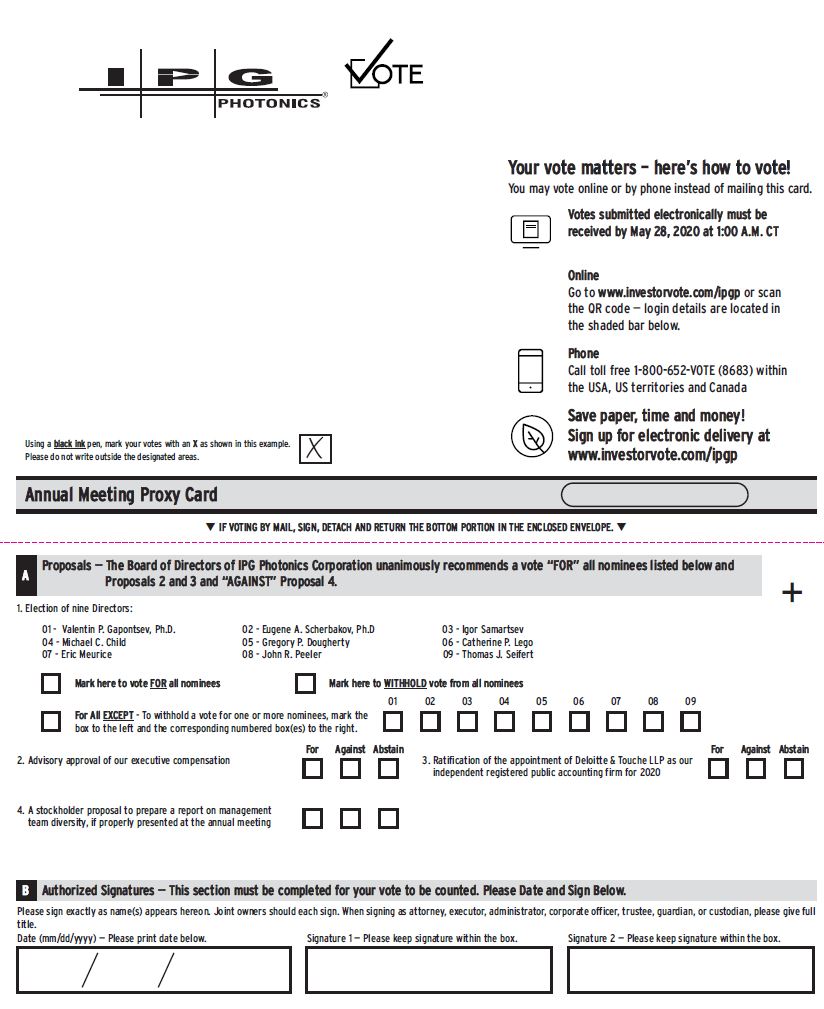UNITED STATES
SECURITIES AND EXCHANGE COMMISSION
Washington, D.C. 20549
(Rule 14a-101)
SCHEDULE 14A
Proxy Statement Pursuant to Section 14(a) of the
Securities Exchange Act of 1934 (Amendment No.__ )
| þ | Filed by the Registrant | ¨ | Filed by a Party other than the Registrant |
| CHECK THE APPROPRIATE BOX: | ||
| ¨ | Preliminary Proxy Statement | |
| ¨ | Confidential, For Use of the Commission Only (as permitted by Rule 14a-6(e)(2)) | |
| þ | Definitive Proxy Statement | |
| ¨ | Definitive Additional Materials | |
| ¨ | Soliciting Material Pursuant to Section 240.14a-12 | |

IPG Photonics Corporation
(Name of Registrant as Specified In Its Charter)
(Name of Person(s) Filing Proxy Statement, if Other Than the Registrant)
| PAYMENT OF FILING FEE (CHECK THE APPROPRIATE BOX): | |||
| þ | No fee required. | ||
| ¨ | Fee computed on table below per Exchange Act Rules 14a-6(i)(1) and 0-11. | ||
| 1) Title of each class of securities to which transaction applies: | |||
| 2) Aggregate number of securities to which transaction applies: | |||
| 3) Per unit price or other underlying value of transaction computed pursuant to Exchange Act Rule 0-11 (set forth the amount on which the filing fee is calculated and state how it was determined): | |||
| 4) Proposed maximum aggregate value of transaction: | |||
| 5) Total fee paid: | |||
| ¨ | Fee paid previously with preliminary materials. | ||
| ¨ | Check box if any part of the fee is offset as provided by Exchange Act Rule 0-11(a)(2) and identify the filing for which the offsetting fee was paid previously. Identify the previous filing by registration statement number, or the form or schedule and the date of its filing. | ||
| 1) Amount previously paid: | |||
| 2) Form, Schedule or Registration Statement No.: | |||
| 3) Filing Party: | |||
| 4) Date Filed: | |||
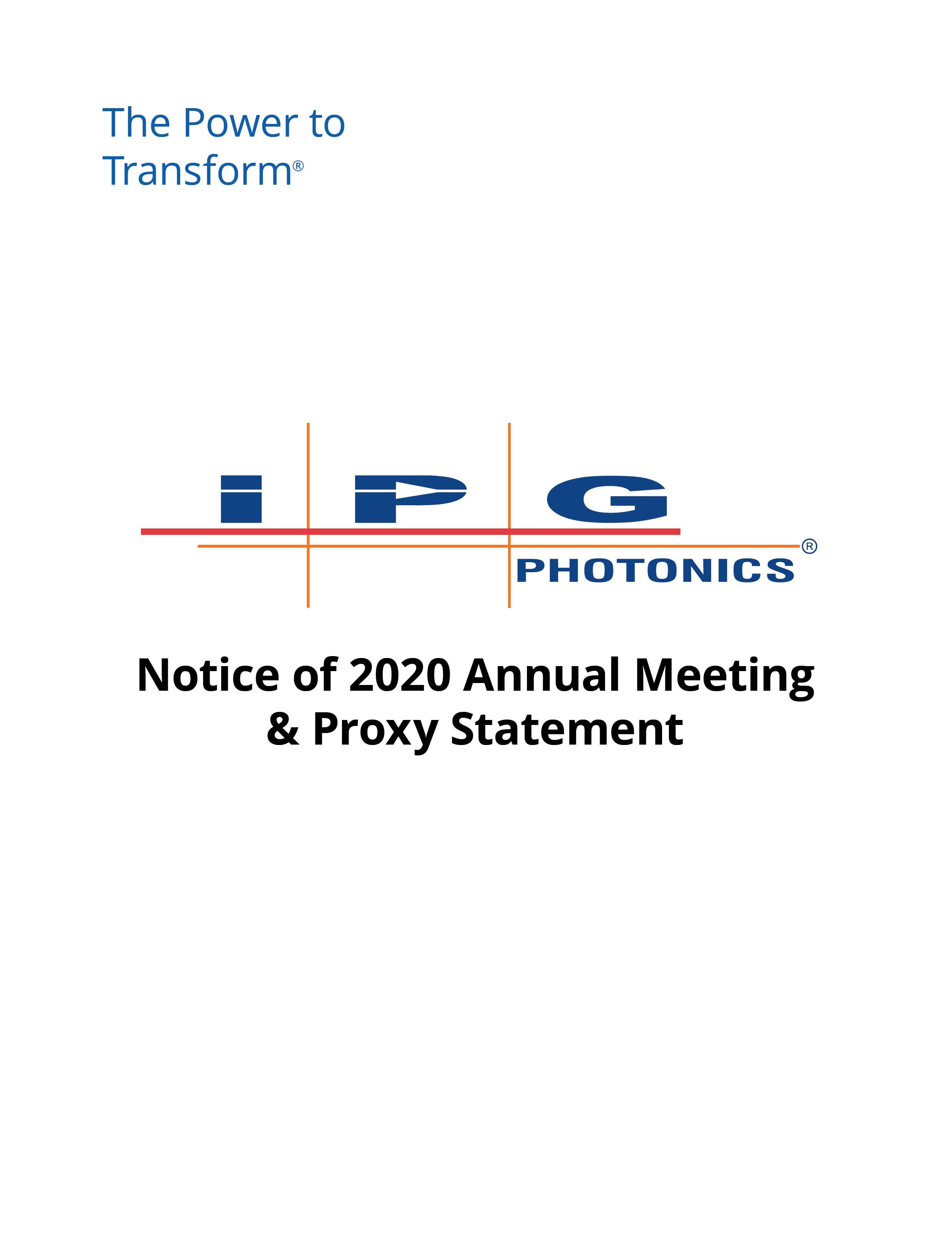
 | |
| IPG Photonics Corporation | |
| 2020 Annual Letter | |
Valentin P. Gapontsev, Ph.D. Chairman and Chief Executive Officer |  |
| To Our Stockholders, | |
Although 2019 proved to be a challenging year, we demonstrated good progress in a number of key growth initiatives. We delivered product cost reductions and differentiated new features and accessories for our core products. Furthermore, we are leveraging one of the largest R&D investments in the laser industry to launch leading edge laser products and systems for new markets to enhance our growth and margin profile and provide greater geographic and end market diversification. The weaker global macroeconomic backdrop, US-China trade conflict and a more intense competitive landscape in China affected our 2019 financial performance. As a result of these challenges, we experienced a significant decrease in the average selling prices for our products in China, which reduced the dollar value of the laser cutting market. Although we shipped a record number of high power lasers, increasing laser units at 1 kilowatt or greater by 23%, achieving revenue growth was challenging. Despite this challenge, we continue to see customers in the laser cutting market adopt higher power solutions. We increased sales of lasers at 10 kilowatts or greater by more than 25%, even though the second half of the year was weaker for these ultra high power solutions. | 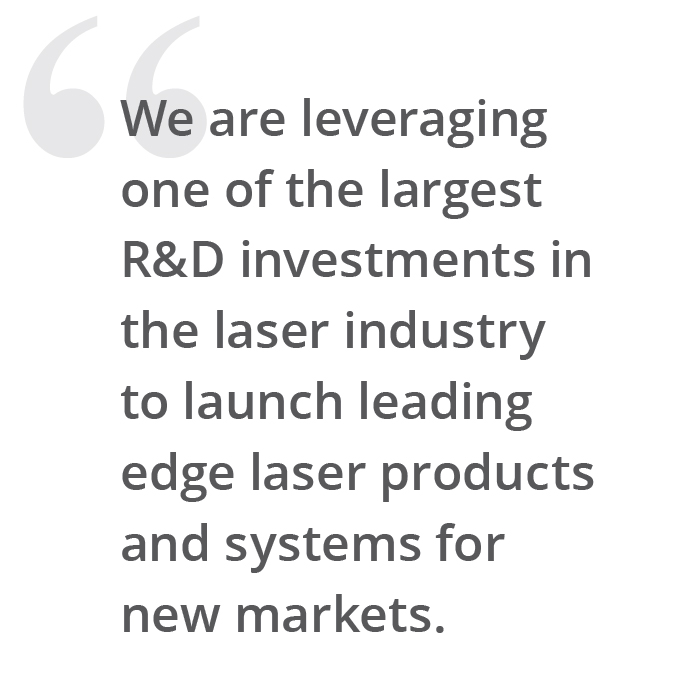 |
However, multiple IPG customers are launching new cutting systems using our 12 kilowatt lasers, and we increased sales of 20 kilowatt lasers for cutting applications 8-fold. Many of these are sold with our new ultra high power cutting heads. In addition, we sold our first lasers with high peak power (HPP) and adjustable mode beam (AMB) capability. HPP products deliver peak energy twice the average power of the laser, increasing cutting speed and quality while reducing scrap through closer nesting of parts. Our new AMB lasers permit the broadest range of beam tunability, enabling spatterless welding and enhancing the speed of electric vehicle battery production. When combined with our unique high power pulsed lasers for foil cutting and ultra high power continuous wave (CW) lasers for welding, we see significant opportunities in the electric vehicle battery market in 2020 and beyond. Augmenting our laser solutions with high power optical heads is a key differentiator versus our laser competitors. In 2019, we delivered record sales of optical heads and other beam delivery accessories, growing sales of these products by 10%. We also shipped our first volume orders of our Laser Depth Dynamics (LDD) process monitoring systems, our patented real-time weld monitoring solution. LDD enables greater use of laser-based welding in automated production environments, and we are pursuing multiple million dollar plus opportunities with this technology and associated laser product sales. Further, we sold a record number of systems for materials processing in 2019 with revenue increasing 33% excluding Genesis, acquired in December 2018. Standard and custom systems for vehicle and battery production, medical device manufacturing, pipe welding, cleaning and inspection applications drove systems growth. We plan to leverage Genesis’ expertise in robotic systems integration to accelerate laser processing within the transportation, aerospace and industrial end markets. | |
 1
1| Product innovation remains core to our success and the source of growth over the coming years. In 2019, new product sales were 19% of total revenue and 24% in the fourth quarter alone. Sales of green pulsed lasers used to improve solar cell efficiency increased by more than 60% in 2019. Sales of ultrafast pulsed lasers increased more than 80% year over year off a small base, with more than 50 new projects for these lasers across a wide range of applications processing glass, ceramics, circuit boards, OLED film, batteries and solar cells. We plan to enhance the pulse energy and expand the portfolio of new green, ultraviolet and ultrafast pulsed lasers to increase our available markets. | |
Sales of medical lasers increased 80% in 2019 as our fiber laser-based system solution received approvals in China and the US. We expect sales into urology and other soft tissue applications to ramp over the coming years off a low base. Our lithotripsy medical laser application uses consumable fibers, which have the potential to develop into a more meaningful recurring revenue stream as the number of installed systems increases. We continue to invest in transformative new products for new application areas as well, including new medical treatments, mid-infrared lasers for spectroscopy, inspection and sensing applications, and ultra high power single mode lasers for aerospace and defense. We have one of the strongest balance sheets in the industrial automation industry, with more than $1 billion net cash and ample liquidity. This strength allows us to prioritize R&D investments and capital expenditures focusing on long-term objectives - diversifying our business with new products, finding new markets and driving innovations to maintain and increase margins. In 2019, we spent $130 million on research and development and $134 million on capital expenditures for these purposes. In addition, we repurchased $41 million worth of stock and have offset all dilution from employee equity compensation since our anti-dilutive repurchase program began in July 2016. |  |
We believe we have significant long-term growth opportunities in laser welding, fine processing of electric vehicle batteries and our portfolio of new products addressing opportunities in micro processing, medical, systems and beam delivery solutions. Within our core business, we believe there is no company that can deliver high power laser solutions at our quality, scale, cost and lead time. We will rely on our core scientific strengths to optimize investment in strategic initiatives critical to the long-term success of the Company, enabling IPG to deliver strong growth in revenue and cash flow. I want to thank our talented employees for their hard work during a difficult year. I would also like to thank you, our stockholders, for your loyalty and support. As ever, I remain confident in our ability to execute during this more challenging period and deliver on our mission to make our fiber laser technology the tool of choice in mass production. | |
 | |
VALENTIN P. GAPONTSEV, PH.D. Chairman and Chief Executive Officer April 1, 2020 | |
2 NOTICE OF 2020 ANNUAL MEETING AND PROXY STATEMENT
Notice of Annual Meeting of Stockholders
DATE AND TIME May 28, 2020 10:00 AM (Eastern Time) | LOCATION IPG Photonics Corporation 50 Old Webster Road Oxford, Massachusetts 01540 | WHO CAN VOTE Only stockholders of record at the close of business on April 1, 2020 may vote at the Annual Meeting |
Voting Items
| Proposals | Board Vote Recommendation | For Further Details | ||
| 1 | Election of nine directors named in this proxy statement | ü FOR each director nominee | Page 12 | |
| 2 | Advisory approval of our executive compensation | ü FOR | Page 37 | |
| 3 | Ratification of the appointment of Deloitte & Touche LLP as our independent registered public accounting firm for 2020 | ü FOR | Page 58 | |
| 4 | A stockholder proposal, if properly presented at the Annual Meeting | û AGAINST | Page 61 | |
Stockholders will also transact any other business that may properly come before the meeting.
You may vote on these matters in person or by proxy. Whether or not you plan to attend the Annual Meeting, we ask that you promptly vote your shares.
We are monitoring coronavirus (COVID-19) developments and the related recommendations and protocols issued by public health authorities and federal, state, and local governments. If we determine that alternative Annual Meeting arrangements are advisable or required, which may include switching to a virtual meeting format, or changing the time, date or location of the Annual Meeting, then we will announce our decision via press release and the filing of additional proxy materials with the Securities and Exchange Commission. Please monitor our investor website (investor.ipgphotonics.com) in advance of the Annual Meeting date if you are planning to attend in person. Food and drink will not be served as in past years.
By order of the Board of Directors
IPG PHOTONICS CORPORATION
IPG PHOTONICS CORPORATION

ANGELO P. LOPRESTI
Secretary
April 1, 2020
Secretary
April 1, 2020
Oxford, Massachusetts
How to Vote
INTERNET Go to www.investorvote.com/ipgp or scan the QR code contained in the attached proxy card | TELEPHONE 1-800-652-VOTE (8683) | MAIL Mark, sign, date and promptly mail the enclosed proxy card in the postage-paid envelope |
| As permitted by the rules of the United States Securities and Exchange Commission (the “SEC”), we are making this Proxy Statement and Annual Report on Form 10-K available to stockholders electronically via the Internet at investor.ipgphotonics.com. On or about April 9, 2020, we will mail to most of our stockholders a notice (the “Notice”) containing instructions on how to access this Proxy Statement and our Annual Report and to vote via the Internet or by telephone. Other stockholders, in accordance with their prior requests, will receive e-mail notification of how to access our proxy materials and vote via the Internet or by telephone, or will be mailed paper copies of our proxy materials and a proxy card on or about April 9, 2020. |
 3
3Proxy Statement Summary
This summary highlights information available within our proxy statement. You should consider all of the information available in this proxy statement (the "Proxy Statement") and our Annual Report on Form 10-K for fiscal year 2019 ("Annual Report") prior to voting your shares. Page references are supplied to help you find further information in this Proxy Statement. In this Proxy Statement, the terms "IPG", the "Company", "we" and "our" refer to IPG Photonics Corporation.
| Company Overview |
IPG Photonics Corporation is the world leader in fiber laser technology, enabling greater precision, higher productivity and more flexible production for industrial applications and other diverse end markets. The Company has a vertically-integrated business model, producing key components of its technology in-house, enabling more powerful and efficient solutions with rapid ongoing cost reduction. Within industrial applications, automated production and miniaturization trends are driving replacement of mechanical machine tools with IPG laser-based solutions. In other end markets, IPG is introducing new products that more than double our addressable market while diversifying end market exposure.
| Performance Highlights |
2019 Highlights
Despite industrial demand headwinds within our largest markets, IPG delivered industry-leading profit and operating cash flow while introducing new solutions that significantly enhance our competitive position and addressable market.
Financial Performance
| NET SALES | OPERATING INCOME |
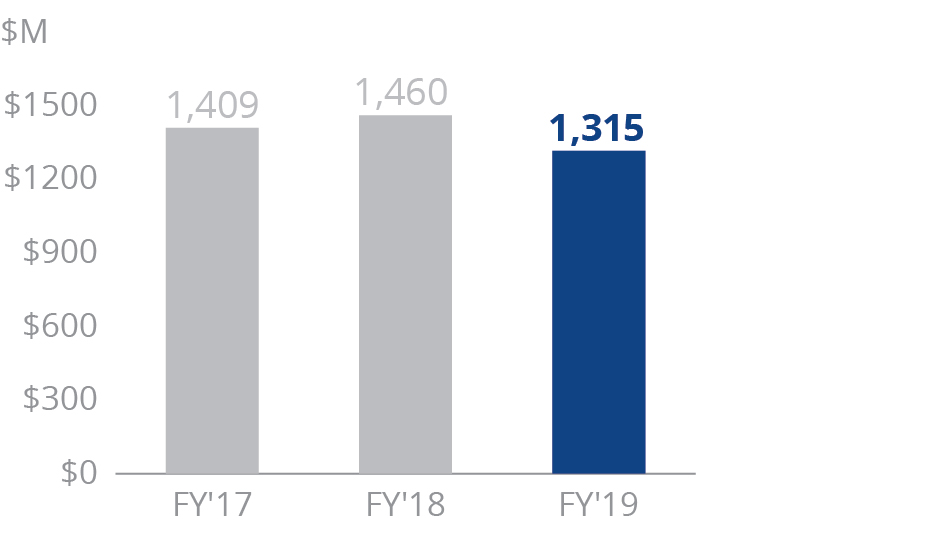 | 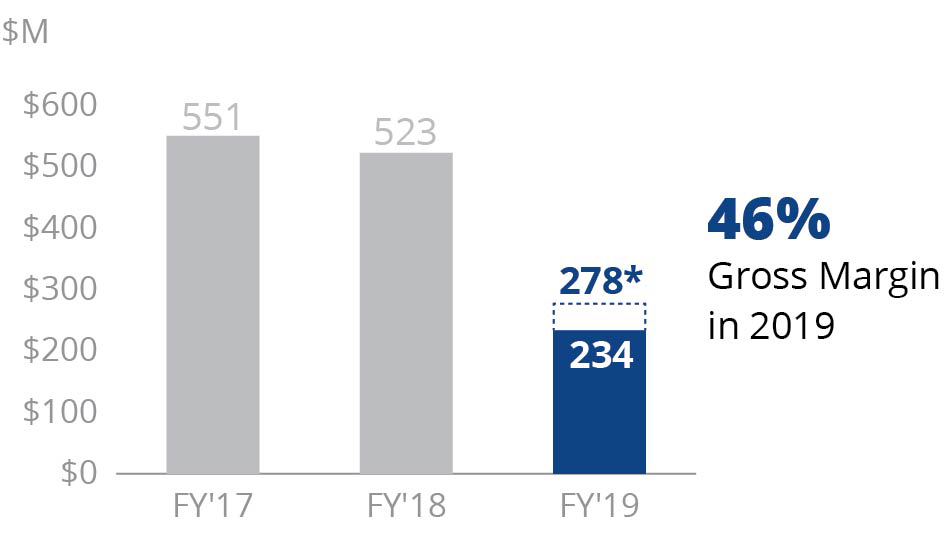 |
| * Excluding extraordinary charges related to impairment of goodwill and other long-lived assets and restructuring. | |
Financial Highlights
| • | Shipped a record number of high power lasers and increased sales of lasers at 10 kilowatts or greater by more than 25% |
| • | Given weaker industrial demand trends resulting from escalation of the US-China trade conflict and macroeconomic challenges in our largest regions, revenue in 2019 decreased by 10% |
| • | As we enhance our capability in providing complete laser solutions to end customers, we sold a record number of laser systems for materials processing in 2019 |
| • | We are leveraging one of the largest R&D investments in the laser industry to launch leading edge products, and in 2019 new product sales were 19% of total revenue |
| • | Because of lower absorption of fixed costs in our vertically-integrated business model, lower product pricing, foreign exchange headwinds and other factors, our industry-leading gross margin declined to 46% |
| • | We delivered operating cash flow of $324 million |
| • | We have one of the strongest balance sheets in the industrial automation industry, with more than $1 billion net cash and ample liquidity at December 31, 2019 |
4 NOTICE OF 2020 ANNUAL MEETING AND PROXY STATEMENT
Proxy Statement Summary
| Voting Items |
Proposal 1 | Election of Nine Directors The Board recommends a vote FOR each director nominee named in this Proxy Statement. | |
See page 12 | ||
Director Nominees
The following provides summary information about each director nominee for our Board of Directors (the "Board").
| Committee Membership | ||||||
| Name and Principal Occupation | Age | Director Since | AC | CC | NCGC | |
 | Valentin P. Gapontsev, Ph.D. | |||||
| Chief Executive Officer and Chairman of the Board | 81 | 1998 | ||||
 | Eugene A. Scherbakov, Ph.D. | |||||
Chief Operating Officer Managing Director, IPG Laser GmbH | 72 | 2000 | ||||
 | Igor Samartsev | |||||
| Chief Technology Officer | 57 | 2006 | ||||
 | Michael C. Child IND | |||||
| Senior Advisor, T.A. Associates, Inc. | 65 | 2000 | ● | |||
 | Gregory P. Dougherty IND | |||||
| Former CEO, Oclaro, Inc. | 60 | 2019 | ● | ● | ||
 | Catherine P. Lego IND | |||||
| Professional board director | 63 | 2016 | ● | ● | ||
 | Eric Meurice IND | |||||
| Former President, CEO and Chairman, ASML Holding NV | 63 | 2014 | ● | ● | ||
 | John R. Peeler Presiding Independent Director | |||||
| Chairman, Veeco Instruments, Inc. | 65 | 2012 | ● | ● | ||
 | Thomas J. Seifert IND | |||||
| Chief Financial Officer, Cloudflare, Inc. | 56 | 2014 | ● | ● | ||
AC Audit Committee | ● | Chair |
CC Compensation Committee | ● | Member |
NCGC Nominating and Corporate Governance Committee | ||
 5
5Proxy Statement Summary
Board Snapshot*
| DIRECTOR INDEPENDENCE | BALANCED TENURE | AGE | DIVERSITY |
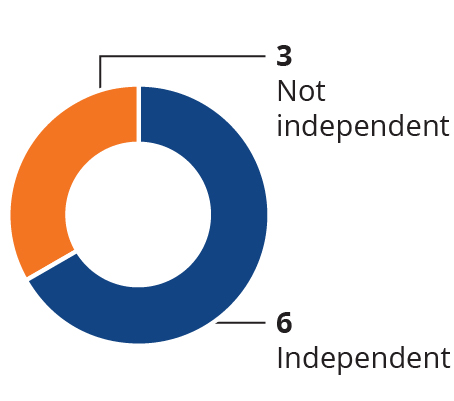 | 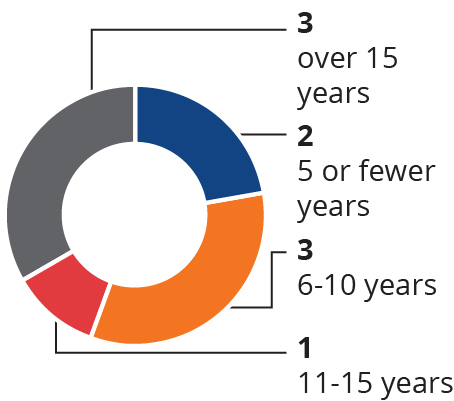 | 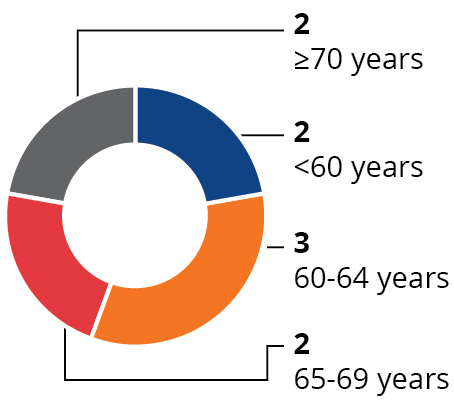 | 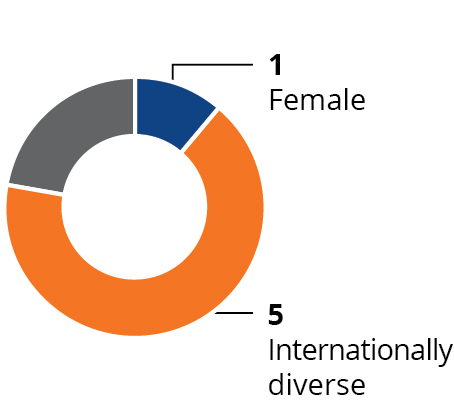 |
6/9 directors are independent** | 11 years Average Tenure | 65 years Average Age | Over 50% Diverse |
| * | Following the Annual Meeting |
| ** | Audit, Compensation and Nominating and Corporate Governance Committees are composed entirely of independent directors |
Skills and Experience*
| Lasers and Technology |  | Business Development and M&A |  | |||
| Financial Literacy |  |  | Risk Management |  | ||
| Global Business |  |  | Executive Leadership |  | ||
| Manufacturing and Operating |  |  | Other Public Company Boards |  | ||
| * | Following the Annual Meeting |
6 NOTICE OF 2020 ANNUAL MEETING AND PROXY STATEMENT
Proxy Statement Summary
Corporate Governance Highlights
ü Stockholder proxy access right adopted in March 2019 ü Director majority voting policy adopted October 2018 ü Ongoing Board refreshment: 1 independent director added in 2019, for a total of 2 directors added in 4 prior fiscal years ü Supermajority of independent directors and 100% independent Board committees | ü 55% of Board members come from internationally diverse backgrounds ü 11% of Board members are women ü Presiding independent director ü Single class of voting stock and no supermajority voting provisions ü Annual election of all directors ü Stockholder right to act by written consent | ü 80% of director compensation at risk based upon stock performance ü Annual Board performance evaluations ü Robust director and executive officer stock ownership guidelines ü Anti-hedging policy applicable to all employees and directors ü Stockholder right to act by written consent |
Stockholder Engagement
We value the views of our stockholders and we believe that building positive relationships with our stockholders is critical to our long-term success. Our investor communications and outreach include periodic site visits, investor conferences and quarterly conference calls. Our quarterly conference calls and presentations at investor conferences are open to the public and are available live and as archived webcasts on our website. During 2019, we engaged with a stockholder with respect to a majority voting by-law provision, which we then adopted. To help management and the Board understand and consider the issues that matter most to our stockholders, we periodically engage with our stockholders on a range of topics including performance, executive compensation, governance and sustainability matters.
Proposal 2 | Advisory Approval of Our Executive Compensation The Board recommends a vote FOR this proposal. | |
See page 37 | ||
 7
7Proxy Statement Summary
2019 Executive Compensation Highlights
As further discussed in Compensation Discussion and Analysis starting on page 38, the guiding principles of our executive compensation philosophy are pay-for-performance, accountability for annual and long-term performance, alignment with stockholders’ interests, and providing competitive pay to attract and retain executives. The 2019 compensation program for our named executive officers ("NEOs") has three primary components: annual base salary, annual cash incentives and long-term equity incentives.
| Fixed | At-risk | |||||||
| Base Salary | Annual Cash Incentive | Long-Term Equity Incentives | ||||||
| Target Mix | CEO* | OTHER NEOs (Average) | CEO | OTHER NEOs (Average) | OTHER NEOs (Average) | |||
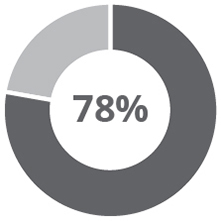 | 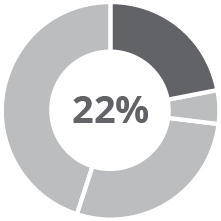 | 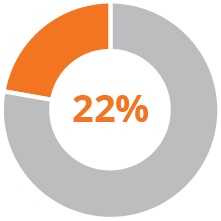 | 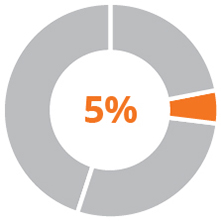 | 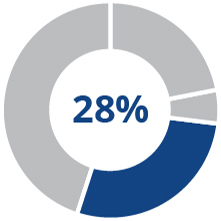 | 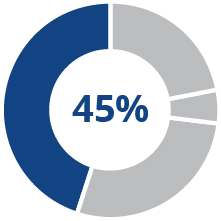 | |||
| * CEO receives no equity awards | Performance based RSUs | Service based Equity Award | ||||||
| Performance | • Executive base salaries were not increased for 2019 in light of the challenging macro-economic environment facing the Company | • Financial performance fell short of minimum revenue and earnings thresholds in 2019, resulting in no annual incentive payout based on financial performance • Individual performance awards were earned for managing through challenging business conditions | • Type and proportion of equity grants reflected a 2019 review by our Compensation Committee with the assistance of our independent compensation consultant of grant practices at peer companies • Our CEO, as the founder and a significant stockholder, has not received an equity award since the Company’s 2006 IPO, resulting in lower compensation expenses and equity burn rate | |||||
| Objective | • Provide a competitive fixed component to attract and retain talented and experienced executives | • Variable cash compensation opportunity is based upon annual net sales and profitability against threshold, target and maximum performance goals • Additional compensation opportunities are based upon individual performance | • Align interests of our executives and stockholders by motivating executive officers to increase long-term stockholder value • Service-based equity awards vest over four years providing long-term retention and additional compensation opportunity for stock price increases • PSU awards provide additional incentives and are earned based on IPG’s total stockholder return relative to a comparable stock index | |||||
8 NOTICE OF 2020 ANNUAL MEETING AND PROXY STATEMENT
Proxy Statement Summary
Alignment with Stockholder Interests and Performance
• Annual cash incentive payouts are capped and have challenging performance goals linked to key financial performance metrics • Long-term equity incentives are aligned with long-term stockholder value creation • Approximately 78% of non-CEO compensation in 2019 was at risk based on performance • Executives exceed stock ownership guidelines, aligning with interests of stockholders | 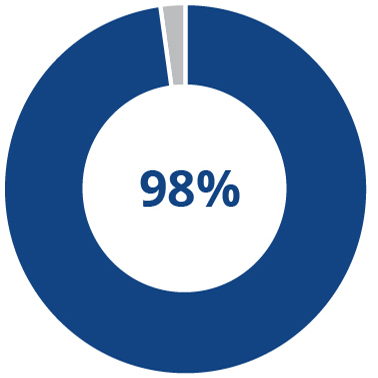 | Say-on-pay approval during last stockholder vote in 2017 |
Governance Features of Our Executive Compensation Program |
| PRACTICES WE EMPLOY | PRACTICES WE AVOID | |
ü Align our officer pay with performance ü Balance annual and long-term incentives ü Use long-term incentives to link executive pay to company performance ü Cap on incentive award payouts ü Maximize stockholder value while mitigating risk ü Independent compensation consultant ü Robust stock ownership requirements ü Clawbacks on executive compensation | û No guaranteed annual bonuses û No retirement benefits û No tax gross-ups û No significant perquisites û Hedging of Company stock is prohibited û No severance for “cause” terminations û No single-trigger change in control provisions û No stock option repricing without stockholder approval û Pledging of Company stock is limited | |
Proposal 3 | Ratify Deloitte & Touche LLP as our Independent Registered Public Accounting Firm for 2020 The Board recommends a vote FOR this proposal. | |
See page 58 | ||
The Audit Committee has sole authority to appoint and replace the Company’s independent registered public accounting firm, which reports directly to the Audit Committee, and is directly responsible for its compensation and oversight of its work. The Audit Committee conducted its annual evaluation of Deloitte & Touche LLP and, after assessing the performance and independence of Deloitte & Touche LLP, the Audit Committee concluded that the best course of action was to reappoint Deloitte & Touche LLP as our independent external auditor for 2020.
We are asking you to ratify this appointment. If stockholders fail to ratify the appointment, the Audit Committee will consider it a directive to consider other accounting firms for the subsequent year.
 9
9Proxy Statement Summary
Fees Paid to Deloitte & Touche. The fees for services provided by Deloitte & Touche LLP, member firm of Deloitte Touche Tohmatsu, and their respective affiliates, to the Company were:
| Fees | ||||||
| Fee Category | 2019 | 2018 | ||||
| Audit fees | $ | 2,440,990 | $ | 2,051,757 | ||
| Audit-related fees | — | 170,470 | ||||
| Tax fees | 90,000 | 111,000 | ||||
| All other fees | — | — | ||||
| Total Fees | $ | 2,530,990 | $ | 2,333,227 | ||
In 2019 and 2018, the percentage of total fees paid to our independent registered public accounting firm for audit fees were 96% and 88%, respectively.
Proposal 4 | Stockholder Proposal to Prepare a Report on Management Team Diversity The Board recommends a vote AGAINST the stockholder proposal to be presented at the meeting. | |
See page 61 | ||
10 NOTICE OF 2020 ANNUAL MEETING AND PROXY STATEMENT
Table of Contents
| Page | |
| 2020 ANNUAL LETTER | |
PROPOSAL 4: STOCKHOLDER PROPOSAL TO PREPARE A REPORT ON MANAGEMENT TEAM DIVERSITY | |
| This Proxy Statement contains certain forward-looking statements within the meaning of the Private Securities Litigation Reform Act of 1995, Section 27A of the Securities Act of 1933, as amended, and Section 21E of the Securities Exchange Act of 1934, as amended, and we intend that such forward-looking statements be subject to the safe harbors created thereby. For this purpose, any statements contained in this Proxy Statement except for historical information are forward-looking statements. Without limiting the generality of the foregoing, words such as “may,” “will,” “expect,” “believe,” “anticipate,” “intend,” “could,” “estimate,” or “continue” or the negative or other variations thereof or comparable terminology are intended to identify forward-looking statements. The forward-looking statements included herein are based on current expectations of our management based on available information and involve a number of risks and uncertainties, all of which are difficult or impossible to accurately predict and many of which are beyond our control. As such, our actual results may differ significantly from those expressed in any forward-looking statements. Factors that may cause or contribute to such differences include, but are not limited to, those discussed in more detail in the section titled “Risk Factors” and elsewhere in our Annual Report and other filings with the SEC. We undertake no obligation to revise the forward-looking statements contained herein to reflect events or circumstances after the date hereof or to reflect the occurrence of unanticipated events. |
 11
11Proposal 1 | Election of Nine Directors The Board of Directors recommends a vote FOR each director nominee named in this Proxy Statement. | |
| Director Qualifications |
The Nominating and Corporate Governance Committee (the "NCGC") is responsible for identifying and evaluating nominees for director and for recommending to the Board a slate of nominees for election at the Annual Meeting. The NCGC has recommended, and the Board has approved, the following nominees for terms expiring at the annual meeting to be held in 2021, until a successor is elected and qualified or until his or her earlier death, resignation or removal and, unless otherwise marked, a proxy will be voted for such nominees: Dr. Gapontsev, Dr. Scherbakov, Mr. Samartsev, Mr. Child, Mr. Dougherty, Ms. Lego, Mr. Meurice, Mr. Peeler and Mr. Seifert. All of the director nominees set forth in our proxy card have consented to being named in this Proxy Statement and to serving if elected. For more information regarding the nominees for director, see Director Nominees below. Mr. Henry E. Gauthier decided to retire from the Board and will not stand for re-election at the Annual Meeting. We extend our sincere appreciation to Mr. Gauthier for the valuable contributions and guidance he provided to our Company and stockholders during his service as a member of our Board since 2006. At the Annual Meeting our Board size is being reduced from ten to nine directors.
In considering each director nominee and the composition of the Board as a whole, the NCGC evaluates members based on their expertise and diverse perspectives, experiences, qualifications, attributes and skills because the NCGC believes that these attributes enable a director nominee to make significant contributions to the Board, IPG and our stockholders.
The director nominees have a mix of various skills and qualifications, some of which are listed in the table below. These collective attributes enable the Board to provide insightful leadership as it strives to advance our strategies and deliver returns to stockholders.
| Lasers and Technology | We have sought directors with management and operational experience in the industries in which we compete. For example, last year we added a director with expertise in optical and electronics components, and telecommunications products. As a diversified technology, science-based company, directors with technology backgrounds understand the Company’s technology platforms and the importance of investing in new technologies for future growth. | |||
 | ||||
| Financial Literacy | Knowledge of finance or financial reporting; experience with debt/capital market transactions and/or mergers and acquisitions strengthen the Board’s oversight of financial reporting and internal controls. Financial metrics are used to measure our performance. All directors must understand finance and financial reporting processes. Two of the Audit Committee members qualify as “audit committee financial experts.” | |||
 | ||||
| Global Business | Global business experience is critical to the Company’s international operations and growth with 79% of sales from outside the U.S. in 2019. Knowledge of Asian and European business practices are valuable to understanding our business and strategy. | |||
 | ||||
| Manufacturing and Operating | As a vertically-integrated company, manufacturing experience and customer service on a global scale are important to understanding the operations and capital needs of the Company. | |||
 | ||||
12 NOTICE OF 2020 ANNUAL MEETING AND PROXY STATEMENT
Proposal 1 Election of Nine Directors
| Business Development and M&A | We have used and will continue to use acquisitions to achieve our strategic goals. Directors with experience in business development and mergers and acquisitions provide valuable perspectives regarding process, due diligence, risk assessment and integration of potential partners. | |||
 | ||||
| Risk Management | In light of the Board’s role in overseeing risk management and understanding the most significant risks facing the Company, including cybersecurity risk, we continue to require directors with experience in risk management and oversight. | |||
 | ||||
| Executive Leadership | Significant leadership experience, including services as a CEO, senior executive, division president or functional leader within a complex organization enhances the Board’s leadership role. | |||
 | ||||
| Other Public Company Boards | Directors with current or recent membership on other public company boards provide valuable perspectives in many areas including operations, strategy, governance and compensation. | |||
 | ||||
| Gapontsev | Scherbakov | Samartsev | Child | Dougherty | Lego | Meurice | Peeler | Seifert | ||
| Skills and Expertise | ||||||||||
| Lasers and Technology | ● | ● | ● | ● | ● | ● | ||||
| Financial Literacy | ● | ● | ● | ● | ● | ● | ● | ● | ● | |
| Global Business | ● | ● | ● | ● | ● | ● | ● | ● | ● | |
| Manufacturing and Operating | ● | ● | ● | ● | ● | ● | ● | |||
| Business Development and M&A | ● | ● | ● | ● | ● | ● | ● | ● | ||
| Risk Management | ● | ● | ● | ● | ● | ● | ● | ● | ● | |
| Executive Leadership | ● | ● | ● | ● | ● | ● | ● | |||
| Other Public Company Boards | ● | ● | ● | ● | ● | ● | ||||
| Background | ||||||||||
| Years on Board | 22 | 20 | 14 | 20 | 1 | 4 | 6 | 8 | 6 | |
| Age | 81 | 72 | 57 | 65 | 60 | 63 | 63 | 65 | 56 | |
| Gender | M | M | M | M | M | F | M | M | M | |
| Internationally Diverse | ● | ● | ● | ● | ● | |||||
 13
13Proposal 1 Election of Nine Directors
| Director Nominees |
The following table sets forth certain information as of the date of this Proxy Statement regarding the director nominees.
Valentin P. Gapontsev, Ph.D.
Chief Executive Officer and Chairman of the Board
 | Dr. Gapontsev has been the CEO and Chairman of the Board of IPG since our inception. Prior to founding the Company's predecessor in 1990, Dr. Gapontsev served as senior scientist in laser material physics and head of the laboratory at the Soviet Academy of Science’s Institute of Radio Engineering and Electronics in Moscow. In 2006, he was awarded the Ernst & Young® Entrepreneur of the Year Award for Industrial Products and Services in New England and in 2009, he was awarded the Arthur L. Schawlow Award by the Laser Institute of America. In 2011, he received the Russian Federation National Award in Science and Technology, and he was selected as a Fellow of the Optical Society of America. Dr. Gapontsev holds a Ph.D. in Laser Materials from the Moscow Institute of Physics and Technology. KEY ATTRIBUTES, EXPERIENCE AND SKILLS Dr. Gapontsev is the founder of the Company and has successfully led the Company and the Board since the Company was formed to now. In the roles of CEO and Chairman of the Board, he has been responsible for formulation and execution of IPG’s strategy and providing leadership and oversight of IPG’s business during a period of rapid and profitable growth, as well as business contractions. He has over thirty years of academic research experience in the fields of solid state laser materials, laser spectroscopy and non-radiative energy transfer between rare earth ions and is the author of many scientific publications and several international patents. His strategic foresight and entrepreneurial spirit along with his deep scientific understanding has guided the Company’s continued growth and technology leadership. | ||||||||
AGE: 81 DIRECTOR SINCE: 1998 COMMITTEES: None | |||||||||
 | |||||||||
| Lasers and Technology | Financial Literacy | Global Business | Manufacturing and Operating | Business Development and M&A | Risk Management | Executive Leadership | |||
14 NOTICE OF 2020 ANNUAL MEETING AND PROXY STATEMENT
Proposal 1 Election of Nine Directors
Eugene A. Scherbakov, Ph.D.
Chief Operating Officer, Managing Director of IPG Laser GmbH and Senior Vice President of Europe
 | Dr. Scherbakov has served as Chief Operating Officer since February 2017, Managing Director of IPG Laser GmbH, our German subsidiary, since August 2000 and Senior Vice President-Europe since 2013. He served as the Technical Director of IPG Laser from 1995 to August 2000. From 1983 to 1995, Dr. Scherbakov was a senior scientist in fiber optics and head of the optical communications laboratory at the General Physics Institute, Russian Academy of Science in Moscow. Dr. Scherbakov graduated from the Moscow Physics and Technology Institute with an M.S. in Physics. In addition, Dr. Scherbakov attended the Russian Academy of Science in Moscow, where he received a Ph.D. in Quantum Electronics from its Lebedev Physics Institute and a Dr.Sci. degree in Laser Physics from its General Physics Institute. KEY ATTRIBUTES, EXPERIENCE AND SKILLS Dr. Scherbakov has extensive knowledge of the Company’s business as Managing Director of IPG Laser GmbH, which produces a large volume of our products and is the source of many developments in products, technology and applications. He applies his knowledge and experience across our many international branches. The leadership and operational expertise of Dr. Scherbakov have contributed to IPG increasing production, lowering manufacturing costs, managing risk and maintaining high margins compared to our industry peers. He also has extensive technological knowledge of fiber lasers, their components and manufacturing processes. His service as an executive officer of the Company provides the Board with a detailed understanding of the Company’s operations, sales and customers. | ||||||||
AGE: 72 DIRECTOR SINCE: 2000 COMMITTEES: None | |||||||||
 | |||||||||
| Lasers and Technology | Financial Literacy | Global Business | Manufacturing and Operating | Business Development and M&A | Risk Management | Executive Leadership | |||
 15
15Proposal 1 Election of Nine Directors
Igor Samartsev
Chief Technology Officer
 | Since 2011, Mr. Samartsev has served as our Chief Technology Officer. Prior to that time, he served in management and technical leadership roles at NTO IRE-Polus, our subsidiary in Russia. Mr. Samartsev holds an M.S. in Physics from the Moscow Institute of Physics and Technology. KEY ATTRIBUTES, EXPERIENCE AND SKILLS Mr. Samartsev is one of the founders of the Company and has a significant management role in the Company as Chief Technology Officer. As one of the key developers of the technology platform of the Company and leader in the development of many new optical technologies, components and products spanning our global development centers that form part of the Company’s strategic plan, the Board values Mr. Samartsev’s understanding of technology developments at our company. | ||||||||
AGE: 57 DIRECTOR SINCE: 2006 COMMITTEES: None | |||||||||
 | |||||||||
| Lasers and Technology | Financial Literacy | Global Business | Risk Management | Executive Leadership | |||||
Michael C. Child
Independent Director
 | Since July 1982, Mr. Child has been employed by TA Associates, Inc., a private equity investment firm, where he currently serves as Senior Advisor and, prior to January 2011, he was Managing Director. Mr. Child holds a B.S. in Electrical Engineering from the University of California at Davis and an M.B.A. from the Stanford University Graduate School of Business. From September 2011 until December 2015, Mr. Child was a Lecturer at the Stanford University Graduate School of Business. KEY ATTRIBUTES, EXPERIENCE AND SKILLS Mr. Child is an established and experienced investor, including in technology companies, from his three decades of experience at TA Associates, Inc. Over the course of his career, he has overseen numerous investments and sales of portfolio companies, and served on the boards of many public and private companies. Through his experiences, he has gained valuable knowledge in the management, operations and finance of technology growth companies. | ||||||||
AGE: 65 DIRECTOR SINCE: 2000 COMMITTEES: NCGC | |||||||||
 | |||||||||
| Financial Literacy | Global Business | Manufacturing and Operating | Business Development and M&A | Risk Management | Other Public Company Boards | ||||
16 NOTICE OF 2020 ANNUAL MEETING AND PROXY STATEMENT
Proposal 1 Election of Nine Directors
Gregory P. Dougherty
Independent Director
 | Mr. Dougherty served as Chief Executive Officer of Oclaro, Inc., a maker of optical components and modules for the long-haul, metro and data center markets, from June 2013 and has served as a director of Oclaro from April 2009, until its December 2018 acquisition. Prior to Oclaro, Mr. Dougherty served as a director of Avanex Corporation (“Avanex”), a leading global provider of intelligent photonic solutions, from April 2005 to April 2009. Mr. Dougherty also served as a director of Picarro, Inc., a manufacturer of ultra-sensitive gas spectroscopy equipment using laser-based technology, from October 2002 to August 2013, and as its Interim Chief Executive Officer from January 2003 to April 2004. From February 2001 until September 2002, Mr. Dougherty was the Chief Operating Officer at JDS Uniphase Corporation (“JDS”), an optical technology company. Prior to JDS he was the Chief Operating Officer of SDL, Inc., a maker of laser diodes, from March 1997 to February 2001 when they were acquired by JDS. Mr. Dougherty serves on the boards of directors of Infinera Corporation, a provider of optical transport networking equipment, software and services to telecommunications service providers and others, since January 2019, Fabrinet, a provider of advanced optical packaging and precision optical, electro-mechanical, and electronic manufacturing services to OEMs of complex products, since February 2019, and MaxLinear, Inc., a provider of radio frequency (RF), analog and mixed-signal integrated circuits, since March 2020. Mr. Dougherty earned a B.S. in optics from the University of Rochester. KEY ATTRIBUTES, EXPERIENCE AND SKILLS Mr. Dougherty contributes to the Board significant leadership, operations, sales, marketing and general management experience in optics and components for telecommunications and other applications. For over three decades, Mr. Dougherty has worked in the optical and components industry and can provide the Board with insight into the industry and conditions in which the Company operates. Having been recently a CEO at a publicly-held company, he is familiar with a large range of management, corporate and board responsibilities and brings valuable perspectives to the Board as an independent director. | ||||||||
AGE: 60 DIRECTOR SINCE: 2019 COMMITTEES: Audit Committee, Compensation Committee DIRECTORSHIP AT OTHER PUBLIC COMPANY: Infinera Corporation, Fabrinet and MaxLinear, Inc. | |||||||||
 | |||||||||
| Lasers and Technology | Financial Literacy | Global Business | Manufacturing and Operating | Business Development and M&A | Risk Management | Executive Leadership | Other Public Company Boards | ||
 17
17Proposal 1 Election of Nine Directors
Catherine P. Lego
Independent Director
 | Ms. Lego is a professional board member and also provides consulting services to early-stage technology companies. From 1999 to 2009, Ms. Lego served as the general partner of The Photonics Fund, LLP, a venture capital investment firm focused on early stage investing in component, module and systems companies in the fiber optic telecommunications market. She served as the director of finance and investment analyst at Oak Investment Partners from 1981 to 1984, and as a general partner from 1985 to 1992. Ms. Lego serves on the boards of directors of Lam Research Corporation, a semiconductor equipment company, Cypress Semiconductor Corporation, a maker of microcontrollers, integrated circuits and memory devices and Guidewire Software, Inc., a provider of a technology platform for the property and casualty insurance industry. Ms. Lego holds a B.A. in Economics and Biology from Williams College and an M.S. in Accounting from the New York University Stern Graduate School of Business. KEY ATTRIBUTES, EXPERIENCE AND SKILLS Ms. Lego has extensive experience working with advanced technology and semiconductor companies. From her current and prior service on the boards of several technology companies as well as her memberships of other audit, compensation and nominating and corporate governance committees, she is familiar with the issues faced and the processes that boards use to manage growth, risk, accounting, acquisitions, due diligence and integration, compensation and investor relations. In addition, she is a frequent speaker on board governance, ethics and audit quality at directors’ colleges and events, including the E&Y Tapestry and KPMG audit committee round tables. Ms. Lego is a member of the NACD’s Audit Committee Advisory Council. She brings valuable perspectives on the latest developments in audit, compensation and other matters to the Board. | ||||||||
AGE: 63 DIRECTOR SINCE: 2016 COMMITTEES: Audit Committee - Audit Committee Financial Expert, Compensation Committee (Chair) DIRECTORSHIP AT OTHER PUBLIC COMPANY: Lam Research Corporation, Cypress Semiconductor Corporation and Guidewire Software, Inc. | |||||||||
 | |||||||||
| Financial Literacy | Global Business | Business Development and M&A | Risk Management | Other Public Company Boards | |||||
18 NOTICE OF 2020 ANNUAL MEETING AND PROXY STATEMENT
Proposal 1 Election of Nine Directors
Eric Meurice
Independent Director
 | Mr. Meurice was President and Chief Executive Officer of ASML Holding NV, a provider of semiconductor manufacturing equipment and technology, from October 2004 to June 2013, and Chairman until March 2014. From 2001 to 2004, he was Executive Vice President of the Thomson Television Division of Thomson, SA, an electronics manufacturer. From 1995 to 2001, he served as head of Dell Computer’s Western, Eastern Europe and EMEA emerging market businesses. Before 1995, he gained significant technology experience at ITT Semiconductors and at Intel Corporation. Mr. Meurice previously served on the boards of Verigy Ltd., a manufacturer of semiconductor test equipment, ARM Holdings plc, a semiconductor intellectual property supplier, NXP Semiconductors N.V., a semiconductor company, and Meyer Burger Technology AG, a solar equipment vendor. Mr. Meurice serves on the boards of UMICORE S.A., a recycling and materials company, since April 2015, and SOITEC S.A., a semiconductor materials manufacturer, since July 2018, and where he was appointed Chairman since March 2019. Mr. Meurice earned a Master’s degree in Mechanics and Energy Generation at the Ecole Centrale de Paris, a Master’s degree in Economics from la Sorbonne University, Paris, and an M.B.A. from the Stanford University Graduate School of Business. KEY ATTRIBUTES, EXPERIENCE AND SKILLS Mr. Meurice has extensive skills and experience as a manager of several rapidly-growing, complex and global businesses in the capital equipment and electronics fields with several billions of dollars in revenues, most recently as former President and Chief Executive Officer of ASML Holding NV. He has experience managing a publicly-held company as well as experience on serving on several public company boards in the equipment and technology fields. Mr. Meurice also has a record of proven leadership as a strategic thinker, operator and marketer at the businesses he managed. | ||||||||
AGE: 63 DIRECTOR SINCE: 2014 COMMITTEES: NCGC (Chair), Compensation Committee DIRECTORSHIP AT OTHER PUBLIC COMPANY: UMICORE S.A. and SOITEC S.A. | |||||||||
 | |||||||||
| Lasers and Technology | Financial Literacy | Global Business | Manufacturing and Operating | Business Development and M&A | Risk Management | Executive Leadership | Other Public Company Boards | ||
 19
19Proposal 1 Election of Nine Directors
John R. Peeler
Presiding Independent Director
 | Mr. Peeler was Chief Executive Officer of Veeco Instruments Inc. (“Veeco”) from July 2007 until September 2018, and Chairman or Executive Chairman of its board of directors from May 2012 until May 2020. Veeco is a developer and manufacturer of MOCVD, molecular beam epitaxy, ion beam and other advanced thin film processes equipment. He was Executive Vice President of JDS and President of the Communications Test & Measurement Group of JDS, which he joined upon the closing of JDS’s merger with Acterna, Inc. in August 2005. Before joining JDS, Mr. Peeler served as President and Chief Executive Officer of Acterna. He has a B.S. and M.E. in Electrical Engineering from the University of Virginia. KEY ATTRIBUTES, EXPERIENCE AND SKILLS Over the course of his career, Mr. Peeler has managed several high-growth technology companies. In addition, he has developed managerial leadership skills through his former position as Chief Executive Officer of Veeco, a publicly-traded company with substantial international operations. His managerial positions have provided him with in-depth knowledge of the service needs of customers in demanding markets, including semiconductor capital equipment, various manufacturing models, marketing and sales. In these roles, he has also been responsible for attracting and incentivizing executives on his team. These experiences have provided him important insights in support of his positions as Presiding Independent Director and a member of the Compensation Committee and the NCGC. | ||||||||
AGE: 65 DIRECTOR SINCE: 2012 COMMITTEES: Compensation Committee, NCGC DIRECTORSHIP AT OTHER PUBLIC COMPANY: Veeco Instruments Inc. | |||||||||
 | |||||||||
| Lasers and Technology | Financial Literacy | Global Business | Manufacturing and Operating | Business Development and M&A | Risk Management | Executive Leadership | Other Public Company Boards | ||
20 NOTICE OF 2020 ANNUAL MEETING AND PROXY STATEMENT
Proposal 1 Election of Nine Directors
Thomas J. Seifert
Independent Director
 | Mr. Seifert is Chief Financial Officer of Cloudflare, Inc., an internet performance and security provider, from June 2017 to the present. Since February 2018, he is a member of the board of CompuGroup Medical SE, a publicly held company in Germany, which provides software to support medical and organization activities in medical offices and facilities. Mr. Seifert was the Executive Vice President and Chief Financial Officer of Symantec Corporation, a provider of security, backup and availability solutions, from March 2014 to December 2016. Mr. Seifert served as Executive Vice President and Chief Financial Officer of Brightstar Corporation, a wireless distribution and services company, from December 2012 to March 2014. He was Senior Vice President and Chief Financial Officer at Advanced Micro Devices Inc., a semiconductor company, from October 2009 to August 2012, and served as Interim Chief Executive Officer from January 2011 to September 2012. From October 2008 to August 2009, Mr. Seifert served as Chief Operating Officer and Chief Financial Officer of Qimonda AG, a German memory chip manufacturer, and as Chief Operating Officer from June 2004 to October 2008. He also held executive positions at Infineon AG, White Oak Semiconductor, including the position as Chief Executive Officer, and Altis Semiconductor. Mr. Seifert has a Bachelor’s degree and a Master’s degree in Business Administration from Friedrich Alexander University and a Master’s degree in Mathematics and Economics from Wayne State University. KEY ATTRIBUTES, EXPERIENCE AND SKILLS Mr. Seifert has extensive experience as both an operating executive and chief financial officer of large publicly-held international technology businesses, such as Symantec and Advanced Micro Devices. In these and other senior positions, he developed deep financial and accounting knowledge, as well as managerial leadership skills, in larger organizations. With his background in accounting, finance and management, Mr. Seifert brings broad skills and knowledge to the Board, the Audit Committee, and the NCGC including internal controls, mergers and acquisitions, integrations and information technology security. | ||||||||
AGE: 56 DIRECTOR SINCE: 2014 COMMITTEES: Audit Committee (Chair) - Audit Committee Financial Expert, NCGC DIRECTORSHIP AT OTHER PUBLIC COMPANY: CompuGroup Medical, SE | |||||||||
 | |||||||||
| Financial Literacy | Global Business | Manufacturing and Operating | Business Development and M&A | Risk Management | Executive Leadership | Other Public Company Boards | |||
The Board of Directors recommends that you vote FOR each director nominee named in this Proxy Statement. |
 21
21Proposal 1 Election of Nine Directors
| Board Refreshment and Composition |
Board Succession Planning
Our Board’s succession planning focuses primarily on the composition of our Board and its committees, anticipated retirements, succession plans for committee members and chairs, our commitment to Board diversity, and recruiting strategies for adding new directors. In its succession planning, the NCGC and our Board consider the results of our Board’s annual self-assessment, as well as other appropriate information, including the types of skills and experience desirable for future Board members and the needs of our Board and its committees at the time in light of the Company’s long-term strategy.
| • | Thoughtful, Deliberate Board Refreshment Process. The Board’s refreshment actions reflect a thoughtful and deliberate process that was informed by our Company’s strategic needs as well as the Board’s annual self-assessment and director nomination processes. |
| • | Appropriately Balance Experience and Perspectives While Ensuring an Orderly Transition. Our Board has taken care as part of its Board refreshment process to appropriately balance new perspectives and the experience of existing directors while undergoing an orderly transition of roles and responsibilities on the Board and its committees. |
| • | Importance of Board Diversity. In addition, our Board continues to focus on the importance of Board diversity. One of the two new directors who joined our Board since 2016 is female. Gender diverse candidates have been and are included in our board searches. |
DIRECTOR TENURE AND RETIREMENT AGE POLICIES • No Term Limits; Appropriate Balance of Skills, Knowledge, Experience and Perspectives. • Our Board recognizes the importance of periodic Board refreshment and maintaining an appropriate balance of tenure, experience and perspectives on the Board. • We believe it is desirable to maintain a mix of longer-tenured, experienced directors with institutional memory and understanding of our business and culture and newer directors with fresh perspectives. However, we do not impose director tenure limits. • The Board believes that directors should not have an expectation of being renominated annually and that the NCGC’s assessment is a key component of its director nomination process. • In connection with the Board’s annual self-assessment and director nomination processes, the Board considers upcoming retirements, the average tenure and overall mix of individual director tenures of the Board, the overall mix of the skills, knowledge, experience and diversity, each individual director’s performance and contributions to the work of the Board and its committees, the personal circumstances and other time commitments of directors, along with other factors the Board deems appropriate. • The Board believes that, as an alternative to term limits, non-management directors should submit their resignation from the Board upon attaining the age of 72 and on each subsequent anniversary. The Board then considers the needs and circumstances confronting the Board and, upon recommendation of the NCGC, determines whether to accept or decline the resignation. • Our Board’s age resignation policy is intended to facilitate our Board’s recruitment of new directors with appropriate skills, experience and backgrounds and provide for an orderly transition of leadership on our Board. |
22 NOTICE OF 2020 ANNUAL MEETING AND PROXY STATEMENT
Proposal 1 Election of Nine Directors
Board Nomination Process
| 1 |  | 2 |  | 3 |  | 4 |
| EVALUATION OF BOARD COMPOSITION | IDENTIFICATION OF POOL OF CANDIDATES | MEETINGS WITH POTENTIAL CANDIDATES | RECOMMENDATION OF POTENTIAL DIRECTORS FOR APPROVAL | |||
• The NCGC and the Board evaluate Board composition annually and identify skills, experience and capabilities desirable for new directors in light of the Company’s long-term strategy | • The NCGC identifies potential nominees through multiple sources, including third party search firm and input from stakeholders | • Evaluation and assessment of candidate interest, minimum qualifications, conflicts, independence, background and other information • Members of the NCGC, other Board members and executives meet with qualified candidates | • NCGC recommends potential nominees to the Board for approval • Stockholders vote on nominees approved by Board at next annual meeting of stockholders | |||
The NCGC’s evaluation process and criteria does not vary based upon whether a candidate is recommended by a stockholder. However, the procedural requirements set forth in our bylaws and the procedures described below in Additional Information - 2021 Annual Meeting and Nominations must be met.
The composite skills of the Board members and the ability and willingness of individual Board members to complement each other and to rely on each other's knowledge and expertise should produce informed Board members who are not afraid to disagree and who can intelligently assess management's performance and evaluate our strategic direction. In considering whether to recommend any candidate for nomination to the Board, including candidates recommended by stockholders, the NCGC must be satisfied that the recommended nominee meets the following qualifications at a minimum:
| Character and Integrity | Must be an individual of the highest character and integrity |
| Leadership Experience | Demonstrated excellence, leadership and significant experience in their field of endeavor |
| Financial Literacy and Commitment to Representing Stockholders | Ability to read and understand financial statement fundamentals and commitment to representing the long-term interests of the Company’s stockholders, while keeping in perspective the interests of the Company’s customers, employees and the public |
| Independence and Constructive Collegiality | Must have a demonstrated ability to think and act independently as well as the ability to work constructively in a collegial environment. Must satisfy independence criteria of the SEC and NASDAQ, where independence is desired |
| Age | A potential director (excluding any incumbent) cannot be aged less than 21 or greater than 72 years |
| Limit on Other Public Boards | Independent directors – 3 (or 4 with Board approval) CEO - 1 |
The NCGC also considers experience in our industry or markets, international business and cultural experience, experience serving on the boards of public companies, experience acquiring companies and diversity to be favorable characteristics in evaluating recommended nominees. With over two-thirds of our sales and employees in locations outside of the U.S.A., it is important to have the appropriate experience and background coming from being born and operating in other countries. Diversity is meant to be interpreted broadly. It includes gender, age, race, national origin, geographic background and also includes differences of professional experience, global experience, education, and other individual qualities and attributes. The NCGC does not assign specific weights to particular criteria, and no particular criterion is necessarily applicable to all prospective nominees. The NCGC believes that our Board should be composed of directors who, as a group, have the experience and skills that are collectively required to make informed Board decisions, provide effective Board oversight to allow the Board to fulfill its responsibilities.
 23
23Proposal 1 Election of Nine Directors
| Board Roles and Responsibilities |
Role in Risk Management
BOARD OVERSIGHT OF RISK The Board recognizes that effectively monitoring and managing risk are essential to the successful execution of the Company’s strategy. The Board has oversight for risk management at IPG with a focus on the most significant risks facing the Company, including strategic, operational, financial and compliance risks. Upon recommendation of the NCGC, the Board allocates risk oversight responsibility among the full Board, the independent directors acting as a group and the three standing committees of the Board as described below. Throughout the year, the Board, the independent directors and the committees to which the Board has delegated responsibility dedicate a portion of their meetings to review and discuss specific risk topics in greater detail. | ||
 | ||
AUDIT COMMITTEE The Audit Committee oversees the policies, processes and risk relating to the financial statements, financial reporting processes, auditing, cybersecurity and compliance risks. The Audit Committee discusses with management the Company’s risk assessment and risk management practices and, when reviewing and approving the annual audit plan for the Company’s internal audit function, prioritizes audit focus areas based on their potential risk. | COMPENSATION COMMITTEE The Compensation Committee oversees risk associated with management resources, including executive retention and non-CEO succession planning. It reviews the Company’s executive compensation practices, their effectiveness at linking executive pay to performance and aligning the interests of our executives and our stockholders, without encouraging excessive risk taking. The Compensation Committee annually reviews management’s assessment of compensation risk. | THE NOMINATING AND CORPORATE GOVERNANCE COMMITTEE The NCGC oversees risk related to the Company’s governance structure and processes, and risks arising from related person transactions. It reviews processes and risk related to Board succession planning, authority delegated to management and certain compliance risk. |
 | ||
FULL BOARD Our entire Board as a whole reviews risk management practices and a number of significant risks in the course of its reviews of corporate strategy, management reports and others. | ||
 | ||
INDEPENDENT DIRECTORS As a group, the independent directors oversee risks related to CEO succession planning. | ||
The Board’s risk oversight process builds upon management’s risk assessment and mitigation processes, which include reviews of strategic and operational planning; compliance under the Company’s Code of Business Conduct and other policies; the Company’s integrity programs; health, safety and environmental compliance; financial reporting and controllership; and information technology and cybersecurity programs. The Board's oversight role is independent from the Company’s day-to-day management, as more than two-thirds of the current directors are independent and therefore have no conflicts that might discourage critical review of the Company’s risks.
24 NOTICE OF 2020 ANNUAL MEETING AND PROXY STATEMENT
Proposal 1 Election of Nine Directors
Role in Management Succession Planning
The Board is focused on ensuring that the Company has emergency and long-term succession plans in place for key senior executive positions. The entire Board annually reviews with the CEO the Company’s plan for succession for the position of the chief executive officer, including the appropriate individual or individuals who are candidates to succeed to this position. In the event of an unexpected departure of the CEO, an emergency succession plan allows for smooth transfer of responsibilities to an individual who may or may not be permanently tasked with the new role. The Compensation Committee, composed entirely of independent directors, periodically reviews the Company’s plan for succession for other senior executive officers.
If the succession plan is triggered for any of these roles, the full Board would participate in the discussion and consideration of any action with a final decision to be made by the full Board. In the event of a senior executive’s departure, both internal and external candidates may be considered for permanent appointment to a given role.
Role in Ethics
All directors, officers and employees are required to abide by IPG’s Code of Business Conduct to ensure that our business is conducted in a consistently legal and ethical manner. These policies form the foundation of a comprehensive process that includes compliance with corporate policies and procedures and a Company-wide focus on uncompromising integrity in every aspect of our operations. Our Code of Business Conduct covers many topics, including antitrust and competition law, conflicts of interest, financial reporting, protection of confidential information, and compliance with all laws and regulations applicable to the conduct of our business. All of our directors and employees receive bi-annual training on our Code of Business Conduct, which is posted on our website at investor.ipgphotonics.com/governance/governance-documents. If the Board grants any waivers from our Code of Business Conduct to any directors or executive officers, or if we amend our Code of Business Conduct, we will, if required, disclose these matters via updates on our website.
Role in Stockholder Engagement
Accountability to our stockholders is an important component of the Company’s success. We recognize the value of building informed relationships with our investors that promote further transparency and accountability.
While proxy voting is one direct way to influence corporate behavior, proactive engagement with our investors can be effective and impactful. Investor views are continuously communicated to the Board and are instrumental in the development of our governance, compensation and other policies and inform our business strategy. The Board continues to seek investor input on a range of issues and practices in furtherance of enhancing long-term stockholder value.
| Publish Annual Report and Proxy Statement. Speak with investors about topics to be addressed at the annual meeting. | Review results of the annual meeting, governance trends, regulatory developments. Board conducts annual self-assessment of its performance and effectiveness. | ||||||||
 | |||||||||
| Consider input from investors to enhance disclosures, governance practices and compensation programs. | Communicate investor feedback to the Board. Board uses self-assessment to develop and implement changes improving effectiveness. | ||||||||
 25
25Proposal 1 Election of Nine Directors
| Board Structure |
Board Leadership Structure
| • | Chairman of the Board and Chief Executive Officer: Dr. Valentin P. Gapontsev |
| • | Presiding Independent Director: John R. Peeler |
| ◦ | Presiding Independent Director position is appointed annually by independent directors |
| • | All three Board committees composed of independent directors |
| • | Independent directors meet in executive session at each of the Board's in person meetings and as needed outside of regular meetings |
There is no single board leadership structure that is optimal in all circumstances. The Board, with its diverse skills and experience, considers the most appropriate leadership structure for the Company in the context of the specific circumstances and challenges facing IPG. The directors come from a variety of organizational backgrounds with direct experiences a wide range of leadership and management structures. The independent directors, who comprise two-thirds of our Board, appropriately challenge management and demonstrate the independence necessary for effective oversight. As a result, the Board is in the best position to evaluate the relative benefits and challenges of different leadership structures and ultimately decide which one best serves the interests of our stockholders.
The independent directors believe that having Dr. Gapontsev serve in the combined role of Chairman and CEO is in the best interest of the Company and its stockholders because it allows Dr. Gapontsev to more effectively execute the Company’s strategic initiatives and business plans. He is the Company's founder and beneficially owns approximately 14% of the Company’s common stock. The duality of Dr. Gapontsev’s roles creates clear and unambiguous authority, which is essential to effective management. Further, given that he is closer to the Company’s business than any other Board member and has the benefit of thirty years of operations, technology, strategy and executive management experience within the Company and its subsidiaries, the Board believes that Dr. Gapontsev is best-positioned to set the Board’s agenda and provide leadership of the board of a company operating in a highly technical industry.
The Board also recognizes the importance of having in place, and building upon, a counterbalancing structure to ensure that it functions in an appropriately independent manner. The governance structure approved by the Board endows the position of Presiding Independent Director with leadership duties and responsibilities including:
| • | setting the agenda for and leading executive sessions of the independent directors; |
| • | providing consolidated feedback from those meetings to the Chairman and CEO; |
| • | providing input on Board meeting agendas; |
| • | providing feedback on the quality and quantity of information flow from management; |
| • | calling and managing meetings of the independent directors; |
| • | facilitating discussions outside of scheduled Board meetings among the independent directors on key issues; |
| • | serving as a liaison with the Chairman and CEO; |
| • | interviewing Board candidates; and |
| • | leading the independent directors in setting the Chairman's and CEO's compensation, goals and objectives, and his annual performance evaluation. |
In the event of a crisis, the Presiding Independent Director has an increased role in crisis management oversight. The independent directors of our Board elected Mr. Peeler as the Presiding Independent Director for the term ending May 2020, and this position is voted upon annually by our independent directors.
The Board believes that the position and responsibilities of the Presiding Independent Director and the regular use of executive sessions of the independent directors without the CEO or other executive officers present, along with the Company’s strong committee system and substantial majority of independent directors, allow the Board to maintain effective oversight.
26 NOTICE OF 2020 ANNUAL MEETING AND PROXY STATEMENT
Proposal 1 Election of Nine Directors
Director Independence
Seven of our ten current directors are independent as defined by Nasdaq and SEC rules. A predominantly independent Board ensures that the Board is acting objectively and in the best interests of our stockholders. The independent directors also bring expertise and a diversity of perspectives to the Board. The culture of the Board enables directors to openly express their opinions in the boardroom and to raise challenges. Nasdaq listing standards governing independence require that a majority of the members of the Board be independent as defined by Nasdaq. The Board conducted its annual review of director independence in March 2020. During this review, the Board examined all direct and indirect transactions or relationships between the Company or any of its subsidiaries and each current director and any immediate family member of the director and determined that no material relationships with the Company existed during 2019. On the basis of this review, the Board determined that each of the following directors qualifies as an independent director as defined in Nasdaq guidelines and SEC rules: Michael C. Child, Gregory P. Dougherty, Henry E. Gauthier, Catherine P. Lego, Eric Meurice, John R. Peeler and Thomas J. Seifert. Additionally, the Board has determined that each member of the Audit Committee and the Compensation Committee meets the independence standards specific for members of such committees under Nasdaq guidelines and SEC rules.
Our Corporate Governance Guidelines require that a majority of the Board members must consist of independent directors. In general, our Corporate Governance Guidelines also require that an independent director must have no material relationship with the Company, directly or indirectly, that might interfere with the exercise of independent judgment in the performance of director responsibilities. The Board determines independence on the basis of the standards specified by Nasdaq, the additional standards referenced in our Corporate Governance Guidelines, and other facts and circumstances the Board considers relevant. The NCGC conducts an annual review of the independence of the directors (and candidates for membership on the Board), taking into account all relevant facts and circumstances, and reports its findings to the full Board.
Executive Sessions. Our independent directors meet privately, without employee directors or management present, at least four times during the year. These private sessions are generally held in conjunction with the regular quarterly Board meetings. Other private meetings of the independent directors are held as often as deemed necessary by them and are lead by the Presiding Independent Director. The Audit Committee, the Compensation Committee and the NCGC meet without employee directors or management present from time to time as they deem necessary.
COMPENSATION COMMITTEE INTERLOCKS AND INSIDER PARTICIPATION
No member of our Compensation Committee (Ms. Lego and Messrs. Dougherty, Meurice and Peeler) is or has been an officer or employee of our Company or any of our subsidiaries. None of our executive officers served as a member of:
| • | the compensation committee of another entity in which one of the executive officers of such entity served on our Compensation Committee; |
| • | the compensation committee of another entity in which one of the executive officers of such entity served as a member of our Board; or |
| • | the board of directors of another entity, one of whose executive officers served on our Compensation Committee. |
 27
27Proposal 1 Election of Nine Directors
| Standing Committees and Board Committee Membership |
The Board has a standing Audit Committee, Compensation Committee and NCGC, each composed entirely of non-employee, independent directors. Under their written charters adopted by the Board, each of these committees is authorized and assured appropriate funding to retain and consult with external advisors, consultants and counsel. Below we provide the principal functions and current members of the standing Board committees.
Audit Committee
| MEMBERS | FUNCTIONS: |
Thomas J. Seifert (Chair) Gregory P. Dougherty Henry E. Gauthier Catherine P. Lego Meetings in 2019: 8 | • Providing oversight of financial management, the internal auditor function and the independent auditor. • Providing oversight with respect to our internal controls including that management is maintaining an adequate system of internal control such that there is reasonable assurance that assets are safeguarded and that financial reports are properly prepared; that there is consistent application of generally accepted accounting principles; and that there is compliance with management’s financial reporting policies and procedures. • Pre-approving auditing and permissible non-audit services by our independent auditor, reviewing and discussing out annual and quarterly financial statements and related disclosures, and coordinating. • Meeting periodically with the independent auditor, management and internal auditor function (including in private sessions) to review their work and confirm that they are properly discharging their respective responsibilities. • Appointing the independent auditor. |
The Board has determined that each member of the Audit Committee is independent and financially literate. The Board has designated Ms. Lego and Mr. Seifert, who are each independent directors under the Nasdaq listing standings and the SEC's audit committee requirements, as “audit committee financial experts” pursuant to the SEC’s final rules implementing Section 407 of the Sarbanes-Oxley Act. Stockholders should understand that the designation of Ms. Lego and Mr. Seifert each as an “audit committee financial expert” is an SEC disclosure requirement and that it does not impose upon them any duties, obligations or liabilities that are greater than those imposed on them as members of the Audit Committee and the Board in the absence of such designation.
28 NOTICE OF 2020 ANNUAL MEETING AND PROXY STATEMENT
Proposal 1 Election of Nine Directors
Compensation Committee
| MEMBERS | FUNCTIONS: |
Catherine P. Lego (Chair) Gregory P. Dougherty Eric Meurice John R. Peeler Meetings in 2019: 8 | • Reviewing and recommending to the independent directors the CEO’s base salary and opportunities for annual and long-term compensation. • Reviewing and approving compensation decisions recommended by the CEO for the other executive officers, including setting base salaries, annual performance bonuses, long-term incentive awards, severance benefits and perquisites. • Setting our compensation philosophy and composition of the group of peer companies used for comparison of executive compensation. • Reviewing and recommending for approval by the Board the compensation for non-employee directors. • Administering the equity compensation plans under which we compensate our executive officers and other key employees. • Retaining an independent compensation consultant firm, Radford, a unit of Aon Hewitt (“Radford”), for matters related to executive officer and director compensation, and outside legal counsel to provide advice on compensation-related matters. • Preparing the Compensation Committee Report included in this Proxy Statement on page 37 and overseeing management’s risk assessment of compensation for all employees and compensation-related risks as delegated by the Board. |
Nominating and Corporate Governance Committee
| MEMBERS | FUNCTIONS: |
Eric Meurice (Chair) Michael C. Child John R. Peeler Thomas J. Seifert Meetings in 2019: 5 | • Overseeing matters of corporate governance, including the evaluation of the performance and practices of the Board. • Developing and recommending criteria for Board membership. • Reviewing possible candidates for the Board and recommending director nominees to the Board for approval. • Overseeing the process for the performance evaluations of the Board and its committees. • Engaging in Board succession planning to ensure boardroom skills are aligned with IPG’s long-term strategic plan. • Reviewing and recommending director orientation, stock ownership guidelines, delegation of authority to management, insider trading guidelines, and consider questions of possible conflict of interest, including related party transactions, as such questions arise. • Reviewing and recommending risk oversight responsibilities of the Board and its committees and of the independent directors as a group. |
Each of the Board committees has a written charter that states their respective purposes, goals and responsibilities as well as qualifications for committee membership, appointment and removal, committee structure and operations and reporting to the entire Board. The three committee charters and our Corporate Governance Guidelines can be found at investor.ipgphotonics.com/governance/governance-documents. Information on our website does not constitute part of this Proxy Statement.
 29
29Proposal 1 Election of Nine Directors
| Board Practices, Policies and Processes |
IPG’s Ongoing Commitment to Enhancing Governance Practices
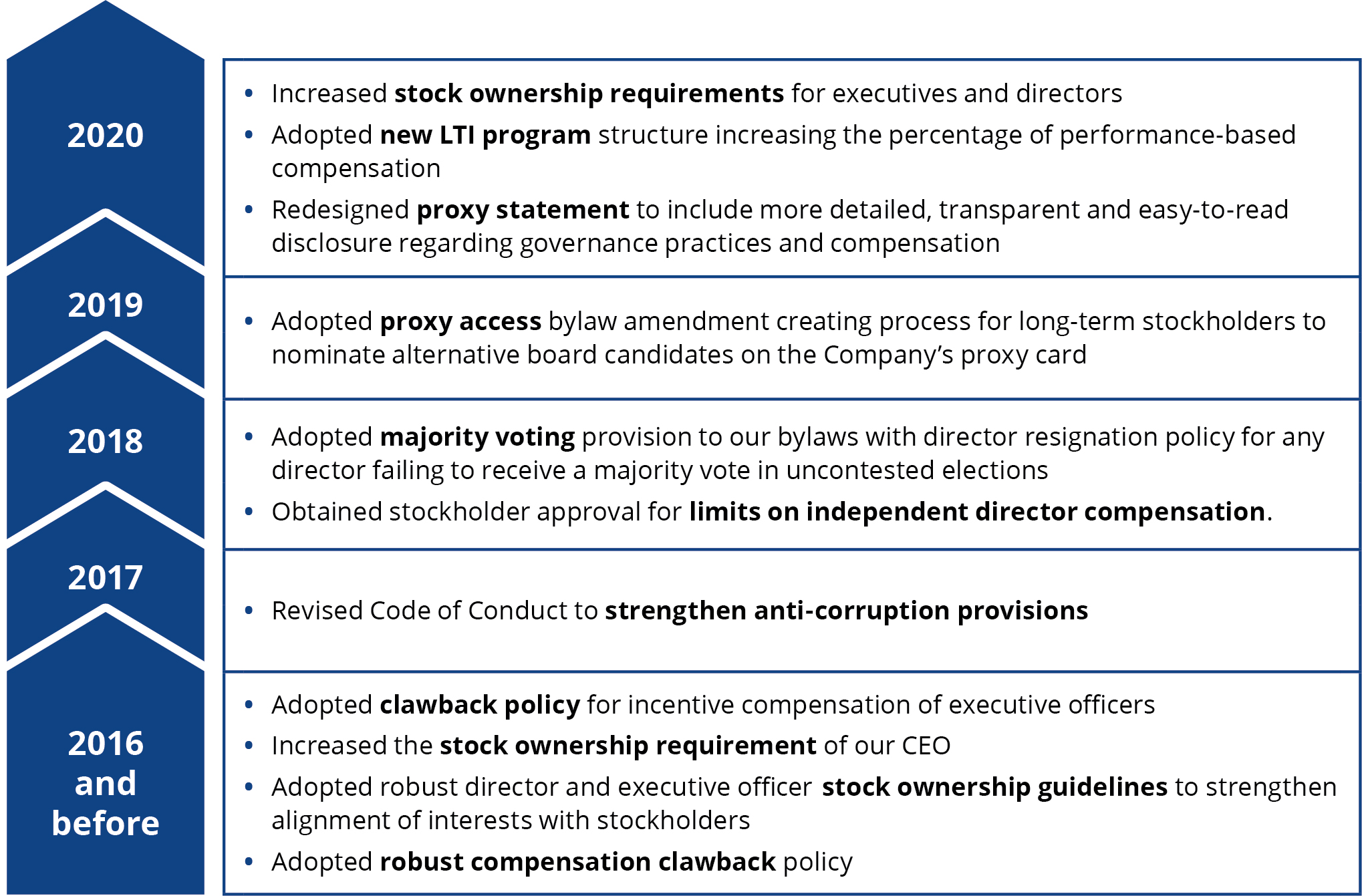
Director Meetings and Policy Regarding Board Attendance
It has been the practice of our Board and its committees to hold at least four in-person regular meetings each year. The Board and its committees also have telephone meetings throughout the year. Our directors are expected to spend the time needed to prepare for and participate in each meeting and to meet as frequently as necessary to properly discharge their responsibilities. We encourage members of our Board to attend annual meetings of stockholders, but we do not have a formal policy requiring them to do so. In 2019, six of the directors in office attended the annual meeting of stockholders.
The table below sets forth the number of meetings held by each committee and the full Board in 2019. All incumbent directors attended 75% or more of the aggregate meetings of the Board and committees on which they served during 2019.
| Board of Directors | Audit | Compensation | Nominating and Corporate Governance | |
| Meetings held in 2019 | 6 | 8 | 8 | 5 |
| Written consents in 2019 | 4 | 0 | 2 | 0 |
30 NOTICE OF 2020 ANNUAL MEETING AND PROXY STATEMENT
Proposal 1 Election of Nine Directors
Corporate Governance Guidelines
Our Board adopted Corporate Governance Guidelines that outline, among other matters, the roles and functions of the Board, the responsibilities of various Board committees and the mission of the Board. Our Corporate Governance Guidelines can be found at investor.ipgphotonics.com/governance/governance-documents. Information on our website does not constitute part of this Proxy Statement.
The Corporate Governance Guidelines provide, among other things, that:
| • | a majority of our Board must be independent |
| • | the Presiding Independent Director presides over executive sessions of independent directors |
| • | the Board appoints all members and chairpersons of the Board committees |
| • | the Audit Committee, Compensation Committee, and NCGC consist solely of independent directors |
| • | the independent directors meet periodically in executive sessions without the employee directors or management |
| • | independent directors may not serve on the boards of more than three other public companies or, with the permission of the Board, four; the CEO may not serve on more than one other public company board |
| • | Board self-assessments are conducted annually and |
| • | the Board and key officers should have a meaningful financial stake in the Company. |
The Board monitors changing legal and regulatory requirements, evolving best practices and other developments. The Board modifies the Corporate Governance Guidelines and its other corporate governance policies and practices from time to time, as appropriate.
Director Orientation and Continuing Education
The Board and its committees proactively monitor legislative and regulatory initiatives, as well as other corporate governance trends and their potential impact on the Company. The Board receives presentations from professionals with expertise in corporate law, governance and other related topics. These experts have specialized knowledge of regulatory actions, governance trends and various other corporate governance topics. In 2019, the Board and its committees received presentations on board oversight and stockholder engagement, SEC rulemaking, governance trends, critical accounting matter disclosures and cybersecurity. Additionally, our directors engage in continuing education to remain informed on recent trends applicable to their committee duties.
Likewise, newly elected directors attend a comprehensive director orientation program that covers, among other things, our strategy, business structure, financial performance, and competitive landscape. New committee members are also provided training on committee policies, practices and trends. As part of this program, directors are asked to tour facilities as appropriate. To further familiarize directors with our expanding operations, we conduct Board meetings at our major manufacturing facilities from time to time.
Board Performance Evaluations
The Board conducts annual self-assessments and its committees conduct bi-annual self-assessments to determine whether they are functioning effectively. Further, the performance of the Presiding Independent Director is evaluated annually. The NCGC oversees the Board and committee self-assessments. Each committee also reviews its own performance bi-annually and reports the results to the Board. Each committee reviews and reassesses the adequacy of its charter annually and recommends proposed changes to the Board.
Prohibition on Hedging; Limits on Pledging
Under our insider trading policy, no director or employee, including NEOs, may engage in shorting shares of our common stock; buying or selling puts, calls or derivatives related to our common stock or other Company securities, which includes equity compensation; or engaging in hedging transactions, including through the use of financial instruments such as prepaid variable forwards, equity swaps, collars and exchange funds. No director or officer, including NEOs, may pledge shares constituting more than 20% of his or her total stock ownership. Pledges of shares constituting 20% or less of total stock ownership are subject to certain conditions.
 31
31Proposal 1 Election of Nine Directors
Communication with our Board of Directors
Interested parties wishing to write to the Board, a specified director or a committee of the Board should send correspondence to the Office of the Secretary, IPG Photonics Corporation, 50 Old Webster Road, Oxford, Massachusetts 01540. All written communications received in such manner from stockholders of the Company will be forwarded to the members or committee of the Board to whom the communication is directed or, if the communication is not directed to any particular member(s) or committee(s) of the Board, the communication shall be forwarded to all members of the Board.
Procedures for Submitting Complaints
We have procedures to treat complaints regarding accounting, internal accounting controls, auditing matters, fight against bribery, banking, and financial crime, including submission of confidential and anonymous concerns regarding questionable accounting, internal accounting controls or auditing matters raised by our directors, officers and employees. These procedures are posted on our website at investor.ipgphotonics.com/governance/governance-documents.
Transactions with Related Parties
The Board adopted a related person transaction policy that requires the NCGC to approve or ratify any transaction or series of transactions exceeding $100,000 in which our Company is a participant and any related person has a direct or indirect material interest (other than solely as a result of being a director or trustee or less than 10% owner of another entity) ("Related Party Transactions"). Related persons include our directors, director nominees and officers and their immediate family members and persons sharing their households. It also includes persons controlling more than 5% of our outstanding common stock. Subject to certain exceptions in the policy, related parties are required to notify the NCGC of the Related Party Transaction for an assessment of whether the transaction or proposed transaction should be permitted. Management also has established procedures for monitoring transactions that could be subject to approval or ratification under the Related Party Transactions policy.
In deciding whether to approve or ratify the Related Party Transaction, the NCGC considers relevant facts and circumstances. The committee will take into account, among other factors, whether the transaction is on terms no more favorable than terms generally available to an unaffiliated third party under the same or similar circumstances and the extent of the related person’s interest in the transaction. Once a Related Party Transaction has been identified, the NCGC will review all of the relevant facts and circumstances and approve or disapprove entry into the transaction. Members of the NCGC having an interest in a transaction excuse themselves for the consideration and approval of the transaction in which they have an interest. Certain transactions are exempt from the policy including compensation paid by the Company for service as a director or an officer.
Pursuant to our Corporate Governance Guidelines, we expect each of our directors to ensure that other existing and future commitments do not conflict with or materially interfere with his or her service as a director. In addition, directors are required to inform the chairman of our NCGC prior to joining the Board of another public company to ensure that any potential conflicts, excessive time demands or other issues are carefully considered.
The NCGC reviewed and approved the following Related Party Transaction for 2019 in compliance with our policy:
Dr. Gapontsev leases the annual right to use 25% of the Company’s corporate aircraft under a July 2017 lease agreement (the “Aircraft Lease”) in connection with the purchase of an aircraft. The Aircraft Lease expires in July 2022. The annual lease rate under the Aircraft Lease is $924,700 and future rent payments are adjusted annually. Dr. Gapontsev paid the Company $923,712 in 2019 for use of the aircraft, and in addition, directly paid an unrelated flight management firm for the operating costs of his private use, including pilot fees, fuel and other costs.
32 NOTICE OF 2020 ANNUAL MEETING AND PROXY STATEMENT
Proposal 1 Election of Nine Directors
| Director Compensation |
Our non-employee directors receive the following annual compensation from us:
| Amount | |||
| Board Retainer | $ | 40,000 | |
| Presiding Independent Director Retainer | $ | 20,000 | |
| Audit Committee Retainers | |||
| Chair | $ | 25,000 | |
| Non-Chair | $ | 12,500 | |
| Compensation Committee Retainers | |||
| Chair | $ | 22,500 | |
| Non-Chair | $ | 10,000 | |
| Nominating and Corporate Governance Committee Retainers | |||
| Chair | $ | 17,500 | |
| Non-Chair | $ | 7,500 | |
| Annual Equity Award | $ | 250,000 | |
Following our annual meeting of stockholders in 2019, we granted to non-employee directors their annual equity award: one-third of the award value (determined pursuant to ASC Topic 718) was granted as service-based stock options and two-thirds of the award value was granted as service-based restricted stock units ("RSUs"). The annual awards vest in a single installment on the earlier of the first anniversary of the date of grant or the next annual meeting of stockholders.
Upon election to the Board, each new non-employee director receives a grant (determined pursuant to ASC Topic 718) of $125,000 in stock options and $125,000 in RSUs vesting on the first anniversary of the date of grant subject to the director’s continued service on the Board. If the election to the Board for a new director occurs other than at an annual meeting of stockholders, the subsequent annual equity grant is pro-rated based upon time the director served since first election.
The exercise price of the stock options is the closing market price of our common stock on the date of grant. Any director who retires after at least eight years of service on the Board will be entitled to full vesting of all options and RSUs then held by the director.
2020 Update. Based upon changes to Company-wide equity compensation practices approved for 2020 and based upon recommendations and data provided by the Compensation Committee's independent compensation consultant, Radford, the Board approved changes to the mix of equity-based compensation paid to non-employee directors. Effective after the 2020 Annual Meeting, non-employee directors will receive their entire annual equity award in RSUs. The aggregate amount of equity compensation and vesting conditions remain the same.
 33
33Proposal 1 Election of Nine Directors
Director Compensation Table
The following table summarizes the compensation of each of our non-employee directors for 2019:
| Name | Fees Earned or Paid in Cash ($) | Stock Awards ($)(1) | Option Awards ($)(1) | Total ($) | |
| Michael C. Child | 47,500 | 166,197 | 79,996 | 293,693 | |
| Gregory P. Dougherty | 64,180 | 207,710 | 160,154 | 432,044 | |
| Henry E. Gauthier | 52,500 | 166,197 | 79,996 | 298,693 | |
| Catherine P. Lego | 75,000 | 166,197 | 79,996 | 321,193 | |
| Eric Meurice | 67,500 | 166,197 | 79,996 | 313,693 | |
| John R. Peeler | 77,500 | 166,197 | 79,996 | 323,693 | |
| Thomas J. Seifert | 72,500 | 166,197 | 79,996 | 318,693 | |
(1) | Valuation based on the fair value of the RSU and stock option awards as of the grant date determined pursuant to ASC Topic 718 with respect to 2019. The assumptions that we used with respect to the valuation of restricted stock unit and stock option awards are set forth in Note 12 to our Consolidated Financial Statements in our Annual Report on Form 10-K filed with the SEC on February 24, 2020. On January 23, 2019, Mr. Dougherty was elected to the Board and was granted 807 RSUs and options to purchase 2,325 shares of common stock at an exercise price of $154.88 per share, vesting on February 15, 2020. On May 30, 2019, each continuing director serving on the Board was granted 1,297 RSUs and options to purchase 1,869 shares of common stock at an exercise price of $128.46 per share, except for Mr. Dougherty, who received an award of 648 RSUs and options to purchase 934 shares of common stock, in each case reflecting proration based on the length of his Board service in 2019. The RSUs and options granted on May 30, 2020 vest in a single installment on May 28, 2020. |
Outstanding Equity Awards Table
The following table provides information regarding unexercised stock options and unvested RSUs held by each of our non-employee directors on December 31, 2019:
| Name | Unvested Restricted Stock Units (#) | Total Option Awards Held (#) | Exercisable Option Awards (#) | |
| Michael C. Child | 1,297 | 43,579 | 41,710 | |
| Gregory P. Dougherty | 1,455 | 3,259 | — | |
| Henry E. Gauthier | 1,297 | 10,578 | 8,709 | |
| Catherine P. Lego | 2,050 | 13,829 | 9,833 | |
| Eric Meurice | 1,297 | 20,001 | 18,132 | |
| John R. Peeler | 1,297 | 23,578 | 21,709 | |
| Thomas J. Seifert | 1,297 | 7,677 | 5,808 | |
We also reimburse directors for all reasonable out-of-pocket expenses incurred for attending Board and committee meetings and director education programs. We do not pay our non-employee directors any additional payments or perquisites.
Our certificate of incorporation limits the dollar amount of personal liability of our directors for breaches by them of their fiduciary duties. Our certificate of incorporation requires us to indemnify our directors to the fullest extent permitted by the Delaware General Corporation Law. We have also entered into indemnification agreements with all of our directors and we have purchased directors’ and officers’ liability insurance.
34 NOTICE OF 2020 ANNUAL MEETING AND PROXY STATEMENT
Proposal 1 Election of Nine Directors
Objectives of Director Compensation
Quality non-employee directors are critical to our success. We believe that the two primary duties of non-employee directors are to effectively represent the long-term interests of our stockholders and to provide guidance to management. As such, our compensation program for non-employee directors is designed to meet several key objectives:
| • | Adequately compensate directors for their responsibilities and time commitments and for the personal liabilities and risks that they face as directors of a public company; |
| • | Attract the highest caliber non-employee directors by offering a compensation program consistent with those at companies of similar size, complexity and business character; |
| • | Align the interests of directors with our stockholders by providing a significant portion of compensation in equity and requiring directors to own our stock; and |
| • | Provide compensation that is simple and transparent to stockholders and reflects corporate governance best practices. |
We also believe in aligning director compensation with stockholder interests. In 2019, approximately 80% of independent director compensation was at-risk by being subject to stock price performance.
Elements of Director Compensation
We believe that the following components of our director compensation program support the objectives above:
| • | We provide cash compensation through retainers for Board and committee service, as well as additional cash retainers to the Presiding Independent Director and chairs of our standing Board committees. We do not provide Board and committee meeting fees. Compensating our directors in this manner simplifies the administration of our program and creates greater equality in rewarding service on committees of the Board. The additional retainers compensate directors for the additional responsibilities and time commitments involved with chairperson responsibilities. |
| • | We pay for, provide or reimburse directors for expenses, including business class travel, incurred to attend Board and committee meetings and director education programs. |
| • | Directors do not have a retirement plan. |
| • | Directors who are our employees receive no additional compensation for service on the Board. |
Determining Director Compensation
Our Compensation Committee reviews our director compensation program periodically to confirm that the program remains appropriate and competitive and recommends any changes to our full Board for consideration and approval.
The Compensation Committee engaged Radford to provide a comprehensive review of compensation for non-employee directors in comparison to the same compensation peer group used for the Company’s executive compensation analysis. The analysis included review of cash retainer, initial and annual equity grants, vesting schedules, meeting fees for Board and committee service. After considering the analysis provided by Radford in early 2019, the Committee did not change non-employee director compensation from 2018.
 35
35Proposal 1 Election of Nine Directors
PROCESS FOR DETERMINING NON-EMPLOYEE DIRECTOR COMPENSATION
| 1 |  | 2 |  | 3 |
| The Compensation Committee engages independent compensation consultant to review compensation of non-employee directors as compared to peer group. | The Compensation Committee evaluates independent compensation consultant report, compensation trends, and need to retain and attract high caliber non-employee directors consistent with comparable companies. | The Board considers changes to non-employee directors compensation program recommended by the Compensation Committee. Approved changes generally take effect after disclosure in the proxy statement and the annual meeting of stockholders. | ||
Director and Executive Officer Stock Ownership Guidelines
The Board adopted stock ownership guidelines to more closely align the interests of our directors and executive officers with those of our long-term stockholders. Under the guidelines, the following persons are expected to maintain a minimum investment in our common stock as follows:
| • | Non-employee directors, the lesser of 3,000 shares or three times their annual cash Board retainer (excluding committee retainers); |
| • | The CEO, five times his annual salary; and |
| • | Senior executive officers, the lesser of 5,000 shares or one times their respective annual salaries. |
Vested stock options and unvested RSUs count toward required stock ownership levels. Indirect ownership of shares through a separate legal entity counts toward fulfillment of the ownership guidelines. Ownership requirements are to be achieved no later than four years after the election as a director or as an executive officer, except that prior to such time the director or officer is expected to retain a certain portion of stock issued upon exercise of stock options or vesting of RSUs until the minimum ownership levels are attained. All directors and executive officers were in compliance with our stock ownership guidelines on December 31, 2019.
2020 Update: After a review of peer practices, the NCGC recommended and the Board approved, the following increased stock ownership requirements effective February 2020:
| • | Non-employee directors, five times their annual cash Board retainer (excluding committee retainers); and |
| • | Senior executive officers, two times their respective annual salaries. |
The CEO's stock ownership requirement was not changed. Also, vested stock options no longer count toward required stock ownership levels.
36 NOTICE OF 2020 ANNUAL MEETING AND PROXY STATEMENT
Proposal 2 | Advisory Approval of Our Executive Compensation |
We are asking our stockholders to cast an advisory vote to approve the compensation of the Named Executive Officers as disclosed in this Proxy Statement in accordance with the requirements of Section 14A of the Exchange Act. This proposal gives our stockholders the opportunity to express their views on the design and effectiveness of our executive compensation program. As most recently approved by our stockholders in 2017, we submit this proposal for a non-binding vote on a triennial basis. At the annual meeting of stockholders in 2017, the last time this proposal was up for a non-binding, advisory vote, over 98% of stockholders voted in favor of our executive compensation practices as disclosed in our 2017 proxy statement.
Our compensation program is designed to be simple, effective and link pay to performance. It reflects the size, scope and success of IPG’s business as well as the responsibilities of our NEOs. We believe our compensation program strikes the appropriate balance between utilizing responsible, measured pay practices and effectively incentivizing our executives to dedicate themselves fully to value creation for our stockholders. We encourage you to read the Compensation Discussion and Analysis below and the compensation tables and narrative disclosures that follow for additional details about our 2019 executive compensation program for our NEOs, including information about 2020 compensation.
As an advisory vote, the results of this vote will not be binding upon the Board or the Company. However, the Compensation Committee and the Board value the opinions expressed by our stockholders on this proposal and will consider the outcome of the vote when making future decisions on the compensation of our NEOs.
Thus, the Company is submitting to stockholders the following resolution for their consideration and approval:
RESOLVED, that the stockholders approve, on an advisory basis, the compensation of the Company’s Named Executive Officers as disclosed in this Proxy Statement pursuant to the compensation disclosure rules of the Securities and Exchange Commission (including in the Compensation Discussion and Analysis, the accompanying compensation tables and related narrative).
The Board of Directors recommends that you vote FOR approval of our executive compensation. |
| Compensation Committee Report |
The Compensation Committee of the Board has reviewed and discussed with management the Compensation Discussion and Analysis included in this Proxy Statement. Based on this review and discussion, the Compensation Committee recommended to the Board that the Compensation Discussion and Analysis be included in the Company’s Proxy Statement for the Company’s 2020 Annual Meeting of Stockholders and in the Company’s Annual Report on Form 10-K for the year ended December 31, 2019.
COMPENSATION COMMITTEE
Catherine P. Lego, Chair
Gregory P. Dougherty
Eric Meurice
John R. Peeler
Catherine P. Lego, Chair
Gregory P. Dougherty
Eric Meurice
John R. Peeler
March 18, 2020
The information in the Compensation Committee Report shall not be considered “soliciting material” or “filed” with the SEC, nor shall this information be incorporated by reference into any previous or future filings under the Securities Act of 1933, as amended, or the Securities Exchange Act of 1934, as amended, except to the extent that the Company incorporates it by specific reference.
 37
37Proposal 2 Advisory Approval of Our Executive Compensation
| Compensation Discussion and Analysis |
Executive Overview
This Compensation Discussion and Analysis provides a review of our executive compensation philosophy and program, and Compensation Committee decisions for fiscal 2019. The discussion in this section focuses on the compensation of the NEOs for fiscal 2019, who were:
| VALENTIN P. GAPONTSEV, PH.D. | EUGENE SCHERBAKOV, PH.D. | TIMOTHY P.V. MAMMEN | ANGELO P. LOPRESTI | ALEXANDER OVTCHINNIKOV, PH.D. |
| Chairman and Chief Executive Officer | Chief Operating Officer, the Managing Director of IPG Laser GmbH, our subsidiary, and Senior Vice President, Europe | Senior Vice President and Chief Financial Officer | Senior Vice President, General Counsel and Secretary | Senior Vice President, Components |
Detailed bios of the NEOs are included in the Annual Report.
Financial and Strategic Highlights of 2019
We shipped a record number of high power lasers in 2019 and increased sales of lasers at 10 kilowatts or greater by more than 25%. However, given weaker industrial demand trends resulting from escalation of the US-China trade conflict and macroeconomic challenges in our largest regions, revenue in 2019 decreased by 10%. As we enhance our capability in providing complete laser solutions to end customers, we sold a record number of laser systems for materials processing in 2019. Furthermore, we are leveraging one of the largest R&D investments in the laser industry to launch leading edge products, and in 2019 new product sales were 19% of total revenue. Because of lower absorption of fixed costs in our vertically-integrated production model, lower product pricing, foreign exchange headwinds and other factors, our industry-leading gross margin declined to 46%. We delivered operating cash flow of $324 million in 2019 and maintain one of the strongest balance sheets in the industrial automation industry, with more than $1 billion net cash and ample liquidity at December 31, 2019.
2019 Executive Compensation Highlights and Changes to 2020 Compensation Program
The Compensation Committee held 2019 executive base salaries, target annual incentives and long term equity incentives at 2018 levels, reflecting the global macroeconomic environment existing at the start of 2019. Financial performance fell short of targets in 2019, which resulted in no 2019 annual incentive payouts for financial performance. Variable cash compensation opportunity is based upon annual net sales and profitability against threshold, target and maximum performance goals. Our NEOs earned a smaller payout based upon their individual performance evaluation as they undertook operational improvements to reduce expenses and increase cash flow as the demand downturn continued.
In 2019, our equity-based award program for executives included service-based stock options, service-based RSUs, and performance-based stock units ("PSUs"), with each award type representing approximately one-third of the overall 2019 long-term incentive opportunity (at target for the PSUs). In 2019, the Compensation Committee changed the index against which the relative performance of the Company’s stock is measured for the 2019 PSU awards to the S&P Composite 1500 Electronic Equipment, Instrument and Components Index (“S&P Electronics Index”) because this index has a higher overall correlation among constituents with the Company, and because the Company’s market cap, revenue and volatility are more in line with the range of such measures in the S&P Electronics Index as compared to the Russell 3000 Index used for prior years. IPG is a member of the S&P Electronics Index. Also in 2019, the Compensation Committee modified executive employment agreements allowing the Company to terminate employment for cause if the executive violates the Company’s Code of Business Conduct, and placing limits on certain outside activities without consent of the Board.
For 2020, executive base salaries and target annual incentives remain at 2018 levels; however, changes were made to the amount of equity incentives provided to Dr. Scherbakov and Mr. Mammen. Consistent with our pay-for-performance philosophy, the Compensation Committee modified our executive equity-based award program increasing the percentage of performance-based awards, which will now include an award based upon an operating metric. The Compensation Committee approved 2020 awards comprised of service-based RSUs (50%), and PSUs based upon relative total stockholder return (at target, 25%), and operating cash flow (at target, 25%).
38 NOTICE OF 2020 ANNUAL MEETING AND PROXY STATEMENT
Proposal 2 Advisory Approval of Our Executive Compensation
| Stockholder Feedback | ||
| At our 2017 annual meeting of stockholders, our stockholders overwhelmingly approved our executive compensation structure in a “say-on-pay” advisory vote, voting 98% in favor of our executive compensation structure. As a result of the 2017 vote, the Compensation Committee determined not to change its pay philosophy or practices. Also at our annual meeting in 2017, the advisory proposal to hold “say-on-pay” advisory votes every three years received the greatest amount of votes and, therefore, we elected to submit the advisory “say-on-pay” proposal to our stockholders on a triennial basis. Accordingly, Proposal 2 is the “say-on-pay” vote. |  | Say-on-pay approval during last stockholder vote (2017) |
Executive Compensation Best Practices
| PRACTICES WE EMPLOY | PRACTICES WE AVOID | |
ü Align our NEO Pay with Performance: Strong links of compensation to Company performance and stockholder returns for annual and long term incentives. Annual bonus tied to revenue and net income and long term incentives include performance-based stock units which are earned based upon IPG’s total stockholder return relative to a broad stock market index and stock options which have value only if the stock price increases over the grant date price. ü Balance Annual and Long-Term Incentives: Incentive programs provide an appropriate balance of annual and long-term incentives and include multiple measures of performance. ü Use Long-Term Incentives to Link Executive Pay to Company Performance: Approximately 74% of NEO (other than the CEO) pay consists of long-term incentives linked to increasing our stock price. CEO receives no equity. ü Cap Incentive Award Payouts: Annual incentive plan award payouts and certain long-term incentive awards are capped. ü Maximize Stockholder Value While Mitigating Risk: Service-based equity awards vest over four years. This incentivizes long-term growth and discourages short-term risk taking. ü Independent Compensation Consultant: The Compensation Committee retains a compensation consultant, who is independent and without conflicts of interest with the Company. ü Robust Stock Ownership Requirements: Officers and directors are subject to stock ownership guidelines to further align their interests with stockholder interests. Our NEOs substantially exceed the ownership guidelines. ü Clawbacks on Executive Compensation: We adopted a compensation recovery policy covering cash and equity. | û No Guaranteed Annual Bonuses: Our annual incentive compensation plan is performance-based and does not include any minimum payout levels. û No Retirement Benefits: We have no supplemental executive retirement plans (SERPs) or defined benefit pension plans. û No Tax Gross-Ups: We do not provide tax gross reimbursements for change in control payouts or executive perquisites. û No Significant Perquisites: We provide limited perquisites to our NEOs. û Hedging of Company Stock is Prohibited. û No Severance For “Cause” Terminations. û No Single-Trigger Change in Control Provisions. Equity awards for NEOs generally require a “double-trigger” of both a change-in-control and termination of employment for both cash and equity compensation acceleration. û No Stock Option Repricing without Stockholder Approval. Our equity plans prohibit repricing underwater stock options. û Pledging of Company stock is limited. | |
 39
39Proposal 2 Advisory Approval of Our Executive Compensation
| 2019 Compensation of Named Executive Officers |
Our Business and Our Compensation Philosophy
The guiding principles of our executive compensation philosophy and practices continue to be pay-for-performance, accountability for annual and long-term performance, alignment to stockholders’ interests, and providing competitive pay to attract and retain executives. We believe our compensation program strikes the appropriate balance between utilizing responsible, measured pay practices and effectively incentivizing our executives to dedicate themselves fully to value creation for our stockholders.
Our executive compensation program is designed to focus our executive officers on both annual and long-term financial and operational performance without encouraging unnecessary risk. The following graphs show that approximately 22% of the CEO’s total direct compensation and approximately 78% of the average total direct compensation of all of the other NEOs’, as reflected in the 2019 column of the Summary Compensation Table, is at risk.
Our CEO, the Company’s founder, does not receive long-term incentive compensation because of his significant level of common stock ownership which the independent directors believe provides him with sufficient incentives to act in the best long-term interest of our stockholders. As a result, a smaller percentage of his total compensation is performance-based as compared to the chief executives of our peer companies who typically receive additional compensation in the form of substantial long-term incentives.
40 NOTICE OF 2020 ANNUAL MEETING AND PROXY STATEMENT
Proposal 2 Advisory Approval of Our Executive Compensation
The PSU awards in the chart below are presented at target based upon grant date fair value. The annual incentive plan amounts are presented based on actual amounts earned under the annual incentive plan for services rendered in 2019.
| Compensation Element | Objective | ||
 | Base Salary | • Provide a competitive fixed component of cash compensation to attract and retain talented and experienced executives with the knowledge and skills necessary to achieve the Company’s strategic business objectives • The Compensation Committee uses the services of an independent compensation consultant to assess the base salaries as compared to a competitive target range of the Company’s peer group • The Compensation Committee considers these factors when setting base salaries of the NEOs: scope of the NEO's responsibilities, contributions, skills, knowledge, experience, seniority and annual and long-term Company performance | |
| CEO* | OTHER NEOs | ||
 |  | ||
| * CEO receives no equity awards | |||
 | Annual Incentive Plan | • Offer a variable cash compensation opportunity that may be earned based upon the level of achievement of challenging corporate goals, with an additional compensation opportunity based upon individual performance • Foster a shared commitment among executives through establishment of uniform Company financial goals • Award payouts are subject to a cap of 225% of target in a performance period | |
| CEO | OTHER NEOs | ||
 |  | ||
| Long-Term Incentives | • Align interests of our NEOs (other than our CEO, who does not receive long-term incentive awards) and stockholders by motivating executive officers to increase long-term stockholder value • Service-based equity awards include stock options and RSUs. They offer certainty and long-term retention while providing additional compensation opportunity based upon increased stock price levels. Stock options further align executives with the long-term growth of stockholder value • Performance-based RSUs provide an additional incentive to our NEOs (other than the CEO) and are earned based on the Company's total stockholder return relative to a broad stock market index • Enhance retention with vesting over four years | ||
| OTHER NEOs | |||
 |  | ||
| Performance based RSUs | Service based Equity Award | ||
| 401(k) Retirement Savings Plan | • Provides participants the opportunity to defer a portion of their compensation and receive a company match of 50% of deferrals subject to a maximum of 6% of eligible compensation • The plan is available to all eligible U.S. employees | ||
| Pension Plan | • We provide no pension plan or deferred compensation plan | ||
| Perquisites | • Perquisites are limited | ||
Base Salary
We provide base salary to our NEOs and other employees to compensate them for services rendered on a day-to-day basis during the fiscal year. Unlike annual cash incentives and long-term equity incentives, base salary is not subject to performance risk. The Compensation Committee reviews data provided by its compensation consultant and considers the factors when setting base salaries of the NEOs: experience, skills, seniority, knowledge and responsibilities of the executive and the individual’s performance assessment provided by the CEO. With respect to the CEO, the Compensation Committee additionally considers the performance of the Company as a whole in its recommendation to the independent directors, who set CEO compensation.
 41
41Proposal 2 Advisory Approval of Our Executive Compensation
In 2019, the Compensation Committee evaluated the base salaries and total cash compensation for the NEOs with the assistance of Radford, its independent compensation consultant. Due to the challenging macroeconomic and foreign trade conditions beginning in 2018 and continuing into 2019, the independent directors accepted the Compensation Committee’s recommendation to not increase the base salary of the CEO and the Compensation Committee concurred with the CEO’s recommendation to not increase the base salaries of the other NEOs in 2019.
Annual Incentives
To focus each NEO on the importance of the Company’s performance, a significant portion of the individual’s potential short-term compensation is in the form of annual cash incentive pay that is tied to the achievement of goals set by the Compensation Committee. Our NEOs participate in our Senior Executive Annual Incentive Plan (the “AIP”) administered by the Compensation Committee. The Compensation Committee determines who is eligible to receive awards under the AIP, defines performance goals and objectives for executives, establishes target awards for each participant for the relevant performance period, and determines the percentage of the target award that should be allocated to the achievement of each of the chosen performance goals in consultation with the CEO with respect to other executives.
ILLUSTRATION OF IPG’S ANNUAL INCENTIVE PLAN (AIP)
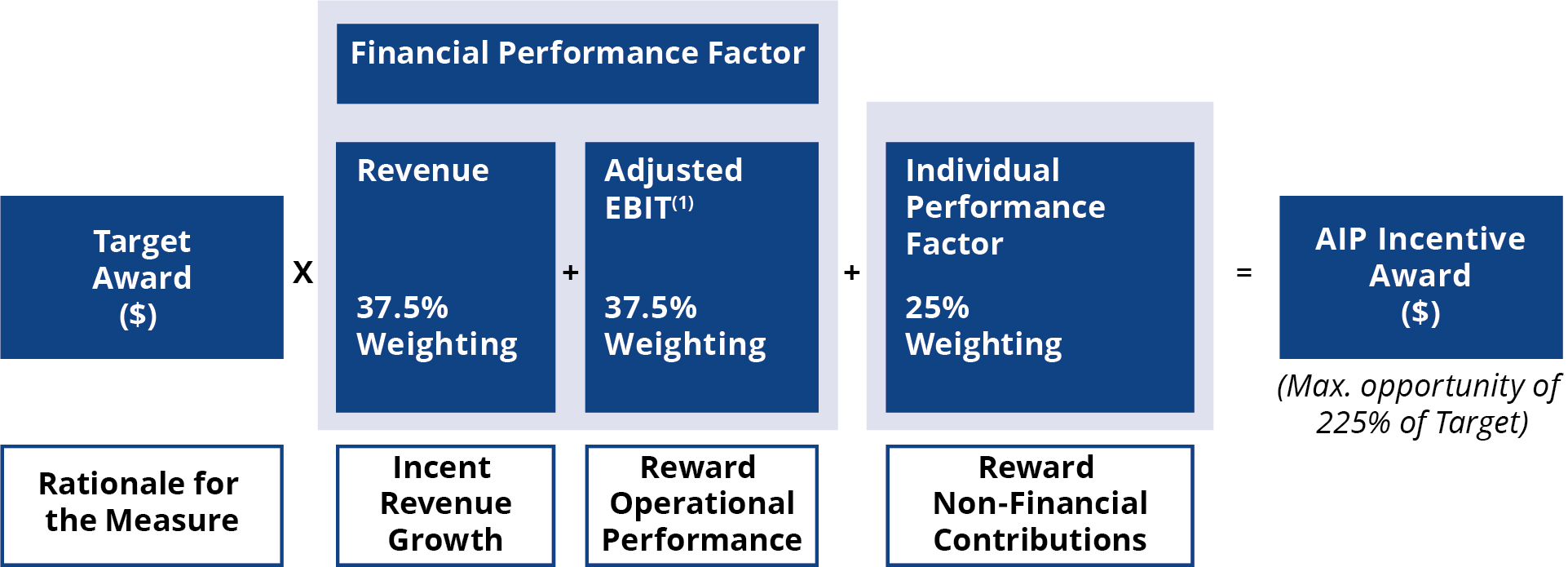
(1) | Non-GAAP “Adjusted EBIT” is an internally defined performance measure that is derived from GAAP net income by adding back the provision for income taxes, interest expense and stock-based compensation expenses and deducting interest income. |
Under the 2019 AIP target approved by the Compensation Committee in February 2019, the NEOs could receive cash incentive payments as a percentage of their base salaries based upon Company performance relative to the financial performance goals. Under the 2019 AIP, if a performance goal is met at the target level as determined by the Compensation Committee, the target bonus is paid for that goal. Performance above target results in a payout of a higher percentage of salary, up to 200% of the NEO’s target cash bonus. Performance below target results in a lower bonus payout for that goal if a minimum threshold is met, with 18.75% of the NEO’s target cash bonus as the minimum in such circumstance, or no payout if the minimum threshold is not met. At target, the financial performance payout accounts for 75% of the overall target award. The CEO and COO can earn up to 25% of their respective target awards based upon goals and objectives determined by the independent directors. For 2019, targets included strategic planning and execution, executive development, inventory management and business growth drivers. The other NEOs also are eligible for payouts up to 25% of the target award based on their individual performance and other factors the Compensation Committee deems relevant.
42 NOTICE OF 2020 ANNUAL MEETING AND PROXY STATEMENT
Proposal 2 Advisory Approval of Our Executive Compensation
2019 AIP FINANCIAL PERFORMANCE TARGETS
($ in millions)
| Threshold 18.75% Payout | Target 100% Payout | Maximum 200% Payout | Component Weighing (%) | Financial Performance Award Earned (%) | |
| Revenue |  | 37.5 | 0 | ||
| Adjusted EBIT |  | 37.5 | 0 | ||
Revenue in 2019 was $1,315 million and adjusted EBIT in 2019 was $312 million, both of which were below the threshold performance required for a payout based on financial performance. At the beginning of 2019, the Compensation Committee set aggressive goals for management based upon improving business conditions seen in late 2018 and early 2019. However, the expected improvements did not materialize as the Company faced worsening conditions from escalations in the U.S.-China trade war in the second quarter, including escalating tariffs and increased customer uncertainty. Continuing macroeconomic challenges in 2019 affected capital equipment purchases in Europe and China, our two largest regions. The impact of increased price competition together with lower industrial machinery purchasing activity adversely affected both revenues and earnings. Each NEO earned the full payouts with respect to the individual performance component as they took undertook operational improvements to reduce expenses and increase cash flow as increased competition and the demand downturn continued. NEOs also guided continued investments in and development of new products.
 43
43Proposal 2 Advisory Approval of Our Executive Compensation
The table below shows, for each NEO, the total target annual incentive award, the threshold, target and maximum payouts with respect to financial performance, the maximum payout with respect to individual performance and actual bonus payouts for 2019.
($ in thousands)
| Named Executive Officer | Target as a % of Base Salary(1) | Target Award(1) | Financial Performance | Individual Performance Maximum | Actual Award | ||
| Threshold | Target | Maximum | |||||
| Valentin P. Gapontsev | 110% | $1,023 |  | $256 | $256 | ||
| Eugene A. Scherbakov | 100% | $679 |  | $154 | $154 | ||
| Timothy P.V. Mammen | 80% | $385 |  | $96 | $96 | ||
| Angelo P. Lopresti | 80% | $350 |  | $88 | $88 | ||
| Alexander Ovtchinnikov | 80% | $350 |  | $88 | $88 | ||
(1) | Target award includes both financial (weighted at 75%) and individual performance (weighted at 25%) targets. Maximum award from all performance elements limited to 225% of target. As noted above, the NEOs received payouts only with respect to individual performance for 2019. |
None of the NEOs' target bonus percentages were increased in 2019 or 2020.
Long-Term Incentives
The goal of our equity-based award program is to provide employees and executives with the perspective of an owner with a long-term financial stake in our success, further increasing alignment with stockholders. Our equity-based incentives align the interests of our executives and stockholders by motivating executives to increase long-term stockholder value.
In 2019, our equity-based award program for our NEOs (other than our CEO) included service-based stock options, service-based RSUs, and PSUs, with each award type representing approximately one-third of the overall 2019 long-term incentive award opportunity (at target for the PSUs). The type and proportion of the equity grants reflected a 2019 review by our Compensation Committee with the assistance of Radford of grant practices at peer companies. The value of stock options, RSUs and PSUs are tied to the Company's stock price which links pay to performance.
Consistent with our pay-for-performance philosophy, the service-based stock option awards have no value unless our stock price increases after the grant date.
The Compensation Committee believes that vesting of awards of service-based options and RSUs over four years provides a strong incentive for executives to remain employed by us and to focus on increasing our financial performance over the long-term, while discouraging excessive short-term risk taking. The Compensation Committee believes that PSUs should vest over three years, rather than four years, because having a four-year performance period would reduce the utility of the performance award and not properly align pay with performance. Service-based RSUs granted in 2019 may be entitled to dividends, should any be paid, at the discretion of the Compensation Committee. Any dividends on shares underlying the PSUs do not vest until the PSUs vest.
44 NOTICE OF 2020 ANNUAL MEETING AND PROXY STATEMENT
Proposal 2 Advisory Approval of Our Executive Compensation
In 2019, the Compensation Committee used competitive market data from the total compensation study of peer companies, balancing the perspective of delivering competitive compensation based upon Black-Scholes option pricing values and Monte Carlo simulations for PSUs. The Compensation Committee analyzed several aspects of the equity grant program, including (i) the “in the money” value, the degree to which executives have incentives to remain employed by the Company through unvested option values, and (ii) the aggregate equity usage in terms of (a) annual usage, typically called burn rate, and (b) cumulative equity delivery, typically called overhang, to determine the dilutive effect of equity awards on investors. The majority of outstanding equity award holdings of the executives were allocated to unvested shares in the aggregate, and all such executives had a minimum of two years’ worth of annual award values in unvested equity value. Based upon this information, Radford advised the Compensation Committee that our equity program provides strong retention incentives.
Since the Company’s initial public offering in 2006, the Compensation Committee has not granted the CEO any equity compensation awards. As the Company’s founder and the beneficial owner of a large number of our shares, he has the perspective of an owner with a significant financial stake in the Company’s success and a long-term outlook. This practice has resulted in substantially lower total compensation earned by our CEO as compared to the chief executives of our named peers despite our outstanding business and earnings growth over the long term. In addition, this practice results in a lower compensation expense and lower equity burn rate for the Company.
For the 2019 PSU awards, the Compensation Committee changed the index against which the relative performance of the Company’s stock is measured. The Compensation Committee considered the analysis of Radford with respect to the current peer index, the Russell 3000, and other peer index alternatives. The Committee selected the S&P Composite 1500 Electronic Equipment, Instrument and Components Index (“S&P Electronics Index”) as the 2019 relative stock index for the PSUs in part because it has a higher overall correlation among constituents with the Company, and the Company’s market cap, revenue and volatility are in line with the range of such measures in the index. IPG is a member of the index. This directly aligns executives’ compensation with stockholders interest because the number of shares earned depends upon performance against the S&P Electronics Index and the value of the shares fluctuates based on the stock price. For each 1% by which the Company's common stock exceeds the performance of the S&P Electronics Index for the trailing 60 trading days from the end of the performance measurement period (March 1, 2022) against the comparable period from the beginning of the performance measurement period (March 1, 2019), the grant recipient would receive a 2% increase in the number of shares above target (up to a maximum share cap of 200% of the target award).
For each 1% by which the Company's common stock falls below the S&P Electronics Index’s performance, the grant recipient would receive a 2% decrease in the number of shares (down to zero). In addition, NEOs cannot receive a number of shares that exceeds 600% of the value of the target award on the date of grant.
The table below provides information on grants of service-based stock options, service-based RSUs and PSUs to the NEOs in 2019. All awards in the table below vest 25% on each anniversary of March 1, 2019, except for the PSUs, which vest on March 1, 2022, the last day of the three-year performance measurement period.
| Name | Service-Based Stock Options (#) | Exercise Price ($) | Service-Based Restricted Stock Units (#) | Performance- Based Stock Units (at Target) (#) | Performance- Based Stock Units Range (Based upon Achievement) (#) | |||||
| Valentin P. Gapontsev | — | — | — | — | — | |||||
| Eugene A. Scherbakov | 17,908 | 154.88 | 6,214 | 6,214 | 0 - 12,428 | |||||
| Timothy P.V. Mammen | 8,654 | 154.88 | 3,003 | 3,003 | 0 - 6,006 | |||||
| Angelo P. Lopresti | 7,540 | 154.88 | 2,616 | 2,616 | 0 - 5,232 | |||||
| Alexander Ovtchinnikov | 7,472 | 154.88 | 2,592 | 2,592 | 0 - 5,184 | |||||
 45
45Proposal 2 Advisory Approval of Our Executive Compensation
Actual Performance of Performance-Based Stock Units. The table below contains information concerning award performance for PSUs awarded from 2016 to 2019.
| 2016 | 2017 | 2018 | 2019 | 2020 | 2021 | |
| 2016 PSUs | ||||||
Target TSR Index (Russell 3000® Index) | 59.7% | |||||
| IPG Performance | 200% | |||||
| Final 2016 Payout | 125% | |||||
 | ||||||
| 2017 PSUs | ||||||
Target TSR Index (Russell 3000® Index) | 47.9% | |||||
| IPG Performance | 31.8% | |||||
| Final 2017 Payout | 67.7% | |||||
 | ||||||
| 2018 PSUs | ||||||
Target TSR Index (Russell 3000® Index) | TBD | |||||
| IPG Performance and Payout | TBD | |||||
 | ||||||
| 2019 PSUs | ||||||
| Target TSR Index (S&P Electronics Index) | TBD | |||||
| IPG Performance and Payout | TBD | |||||
 | ||||||
Other Compensation
Severance Benefits. The severance benefits that we offer to our NEOs assist us in recruiting and retaining talented individuals and are consistent with the range of severance benefits offered by our peer group. The severance provisions of our NEO employment agreements are summarized in Potential Payments upon Termination or Change in Control below.
Retirement Benefits. We do not offer an executive retirement plan or a non-qualified deferred compensation plan. Executives in the United States are eligible to participate in our 401(k) retirement savings plan on the same terms as all other U.S. employees. Our 401(k) retirement savings plan is a tax-qualified plan and therefore is subject to certain Internal Revenue Code limitations on the dollar amounts of deferrals and company contributions that can be made to plan accounts. These limitations apply to our more highly-compensated employees (including the NEOs). We made matching contributions to our employees at a rate of 50% of deferrals subject to a maximum of 6% of eligible compensation under the 401(k) retirement savings plan, including the NEOs, who participate in the plan as set forth in the Summary Compensation Table. Dr. Scherbakov, who resides in Germany, participates in a German government-sponsored retirement program.
46 NOTICE OF 2020 ANNUAL MEETING AND PROXY STATEMENT
Proposal 2 Advisory Approval of Our Executive Compensation
Personal Benefits. Our executives are eligible to participate in employee benefit plans, including medical, dental, life and disability insurance and vacation plans as well as an employee stock purchase plan, which is intended to be qualified under Section 423 of the Code. The employee stock purchase plan allows participants to purchase Company shares at a price equal to 85% of the lesser of the fair market value at the first day or last day of the six month offering period, subject to limitations on the amount of shares. These plans generally are available to all salaried employees and do not discriminate in favor of executives. Benefits are intended to be competitive with the overall market in order to facilitate attraction and retention of high-quality employees.
The Compensation Committee compared the Company’s executive perquisites policies against the 2019 peer group and made no changes. The Company provides the use of a corporate aircraft to the CEO and other executives for business travel integral to the performance of their duties. Executives are encouraged to use the aircraft for efficiency, safety and security. However, executives are not allowed to use the aircraft for personal use that has not been paid for, except that family and other guests may accompany executives on the aircraft for business travel. The Company provides the CEO with a car and driver in the United States so that he may use his travel time for company purposes. The Company also provides Dr. Scherbakov use of an automobile, as it does for other high-ranking employees in Germany.
Executive Compensation Decision-Making
Role of Compensation Committee
The Compensation Committee determines, approves and administers the compensation programs for our executive officers, including our NEOs. The Compensation Committee recommends to the independent directors the CEO’s annual base salary, annual incentive opportunity and long-term incentive opportunity. The independent directors approve the CEO’s compensation and our Compensation Committee approves the compensation for other executive officers in consultation with our CEO. Our Compensation Committee is also responsible for making recommendations to the Board with respect to the adoption of equity plans and certain other benefit plans. The Compensation Committee and the independent directors meet in executive decisions when determining executive compensation.
The Compensation Committee may delegate authority whenever it deems appropriate. In 2019, the Compensation Committee delegated authority to grant equity awards for non-executives to the CEO, subject to certain conditions, including amounts of awards and review of awards by the Compensation Committee.
Our Compensation Committee’s policy is to set executive pay in accordance with the objectives of the Company’s compensation programs as described above. In the Compensation Committee’s view, the Company’s executive compensation program provides an overall level of compensation opportunity that is competitive with peer companies. Actual compensation levels may be greater or less than target compensation levels provided by similar companies based upon annual and long-term Company performance, as well as individual performance, contributions, skills, seniority, knowledge, experience and responsibilities.
Role of Management
The CEO participates in the establishment of compensation levels and payouts for individual performance for other NEOs. He assesses the performance of all NEOs and recommends to the Compensation Committee the overall levels of achievement, and personal performance in the year. Upon request, the NEOs provide supplemental material to the Compensation Committee to assist in the determination and implementation of compensation, policies and practices. The CEO is not involved in decisions regarding the setting of any component of his compensation. The CEO and other members of senior management attend Compensation Committee meetings at the invitation of the Compensation Committee.
Role of Independent Consultant
The Compensation Committee engaged Radford, an independent compensation consultant, to conduct a comprehensive review and analysis of our executive and non-employee director compensation programs and to make recommendations for compensation related to 2019. The consultation included non-executive compensation data and valuation services for equity incentives. Radford’s parent company, Aon Hewitt, does not perform any other work for the Company. The Compensation Committee reviews the independence of Radford in light of SEC rules and Nasdaq listing standards regarding compensation consultants. The Compensation Committee believes that there were no actual or potential conflicts of interest with Radford in 2019.
 47
47Proposal 2 Advisory Approval of Our Executive Compensation
Pay Positioning Strategy and Peer Group
Consistent with prior years, in 2019 the Compensation Committee used competitive compensation data from the annual total compensation study of peer companies to inform its decisions about overall compensation opportunities and specific compensation elements. Additionally, the Committee used multiple reference points when establishing targeted compensation levels. Within the comparative framework, the primary data was the named peer group of specific peers selected by the Compensation Committee and the secondary data was broader, size-appropriate comparisons in the high technology industry using Radford High Technology Survey Data. The Committee does not benchmark specific compensation elements or total compensation to any specific percentile relative to the peer companies or the broader United States market. Instead, the Committee applies judgment and discretion in establishing targeted pay levels, taking into account not only competitive market data, but also factors such as Company, business and individual performance, scope of responsibility, critical needs and skill sets, leadership potential and succession planning. No single factor takes precedence over any other, nor is any formula used in making these decisions.
The peer companies selected by the Compensation Committee are companies that operate in the semiconductor equipment and electronic manufacturing industries, and are comparable in terms of revenue, market capitalization and headcount.
For 2019, the peer companies were:
| Arista Networks, Inc. | Barnes Group, Inc. | Cognex Corporation |
| Coherent, Inc. | Dolby Laboratories, Inc. | Donaldson Company, Inc. |
| Entegris, Inc. | FLIR Systems, Inc. | Graco, Inc. |
| IDEX Corporation | II-VI Incorporated | ITT, Inc. |
| MKS Instruments, Inc. | National Instruments, Inc. | Nordson Corporation |
| Teradyne, Inc. | Trimble Navigation Limited | Waters Corporation |
| Zebra Technologies, Inc. | ||
The Compensation Committee reviews this peer group annually with input from Radford to ensure that the comparisons are meaningful. In this review, the Compensation Committee considers several factors in developing a peer group: it considers the current peer group to determine appropriateness, the peers used by institutional governance advisors, the companies that list our company as a peer to understand crossover peers and broader research based upon established selection criteria to identify potential future peers. The Committee then develops criteria for business sector, revenue, market capitalization and headcount. Radford also supplements its peer analysis with the data from a broader list of high-technology public company participants in the AON Radford Executive Technology Survey targeting technology companies with comparable revenue levels. Companies that are no longer publicly traded are omitted from the peer group. Based upon the process and applying the criteria above, the Compensation Committee applied the methodology above and determined the peer group approved for 2018 continued to be appropriate for 2019.
48 NOTICE OF 2020 ANNUAL MEETING AND PROXY STATEMENT
Proposal 2 Advisory Approval of Our Executive Compensation
COMPANY VS. PEER GROUP

2020 Update. For 2020 compensation determinations, the Compensation Committee reviewed the analysis from Radford regarding the Company’s peer group. Radford performed an analysis of similarly-situated public companies, supplemented the peer group with published survey data providing a broad market representation of companies and deeper position reporting, as well as set parameters for the peer group study. For 2020, the analysis by Radford proposed adding Watts Water Technologies. Inc. (industrial machining) and Lumentum Holdings Inc. (communications networks and lasers), and removing Zebra Technologies (electronics equipment and instruments) and Arista Networks (communications networks) because of their different business focuses. The Compensation Committee approved the proposed changes to the peer group for 2020 compensation determinations.
Other Factors Affecting Compensation
Tax Deductibility under Section 162(m). Section 162(m) of the Internal Revenue Code (“Section 162(m)”) limits the deductibility for federal income tax purposes of certain compensation paid in any year by a publicly held corporation to its “covered employees” as defined by Section 162(m) (generally, our current and former NEOs) to $1 million per executive (the “$1 million cap”). Prior to the enactment of the Tax Cuts and Jobs Act (“TCJA”), Section 162(m) provided an exception from this deduction limitation for certain forms of “performance-based compensation,” which included annual incentive pa youts, the gain recognized by NEOs upon the exercise of stock options and the income recognized on the vesting of performance share awards. Due to the TCJA, the “performance-based” compensation exception to the $1 million cap does not apply for tax years after 2017, unless certain limited transition relief is met. The Compensation Committee retains the discretion to grant or pay compensation that exceeds the $1 million cap or may not qualify for the performance-based compensation exception to Section 162(m). The Compensation Committee believes it is appropriate to retain the flexibility to authorize payments of compensation that may not qualify for deductibility if, in the Compensation Committee’s judgment, it is in the Company’s best interest to do so. In the past, the Compensation Committee generally sought to structure performance-based compensation for our covered employees, and to undertake the required ministerial actions, in a manner that complies with Section 162(m) in order to provide for the deductibility of such compensation to the extent possible. We generally will continue to emphasize performance-based compensation, even though it may no longer be deductible.
Accounting Considerations. We consider the accounting implications of our executive compensation program. In addition, accounting treatment is just one of many factors impacting plan design and pay determinations. Our executive compensation program is designed to achieve a favorable accounting and tax treatment as long as doing so does not conflict with the intended plan design or program objectives.
 49
49Proposal 2 Advisory Approval of Our Executive Compensation
Compensation Risk
Management conducts an annual risk assessment of the Company’s compensation policies and practices for all employees, including non-executives, and reports its findings to the Compensation Committee. In 2019, management concluded that the Company’s compensation policies and practices are balanced and do not motivate imprudent risk taking. Management believes that the Company's compensation policies do not create risks that are reasonably likely to have a material adverse effect on the Company.
In reaching this conclusion, they considered the following factors:
| • | our compensation program is designed to provide a mix of both fixed and variable incentive compensation; |
| • | our senior executives are subject to stock ownership guidelines, which we believe incentivize our executives to consider the long-term interests of the Company and our stockholders and discourage excessive risk-taking that could negatively impact our stock price; |
| • | our senior executives are subject to compensation recovery policy, which discourages excessive risk-taking that could negatively affect our stock price; |
| • | our incentive compensation programs are designed with vesting terms that are relatively consistent, spread out over several years, and do not contain steep payout “cliffs” that might encourage short-term business decisions in order to meet a vesting or payout threshold; and |
| • | our senior executive incentive compensation program caps the amounts that may be paid for performance above target level. |
Other Policies
Anti-Hedging and Limitations on Pledging of Company Stock. The Board adopted policies prohibiting hedging transactions and limiting the pledging of our common stock. Under our insider trading policy, no director or employee may engage in shorting shares of our common stock or any type of securities that we may issue, or buying or selling puts, calls or derivatives related to our common stock. A director or officer of the Company may not pledge shares constituting more than 20% of his or her total stock ownership. Pledges of shares constituting 20% or less of total stock ownership are subject to certain conditions.
Stock Ownership Guidelines. The Board adopted stock ownership guidelines to closely align the interests of our executives with those of our long-term stockholders. Under the guidelines, the CEO is expected to maintain a minimum investment on our common stock of five times his annual salary and other senior executives are expected to maintain a minimum investment on our common stock of the lesser of 5,000 shares or one times their respective annual salaries. All of our senior executives substantially exceed the ownership requirements under our stock ownership guidelines. These ownership levels are to be achieved no later than four years after the election as an executive officer, except that prior to such time the officer is expected to retain a certain portion of stock issued upon exercise of stock options or vesting of restricted stock awards until the minimum ownership levels are attained. For more information, including recent updates to these guidelines, see Proposal 1 - Director Compensation - Director and Executive Officer Stock Ownership Guidelines.
Clawback Policies. In 2015, the Compensation Committee approved a compensation recovery policy that allows the Company to recapture cash and equity performance-based compensation from executives if the amount of the award was based upon achieving certain financial results that were later restated due to the participant’s misconduct. In addition, all equity awarded to employees since 2007 contain a provision under which employees may be required to forfeit equity awards or profit from equity awards if they engage in certain conduct, including competing against the Company, disclosing confidential information, or soliciting its employees or customers.
50 NOTICE OF 2020 ANNUAL MEETING AND PROXY STATEMENT
Executive Compensation Tables
| Executive Compensation Tables |
Summary Compensation Table
The following table provides information regarding compensation earned by our Chief Executive Officer, our Chief Financial Officer and our three other most highly compensated executives for the fiscal years indicated below:
| Name and Principal Position | Year | Salary ($) | Bonus ($) | Stock Awards ($)(1) | Option Awards ($)(1) | Non-Equity Incentive Plan Compensation ($)(2) | All Other Compensation ($)(3) | Total ($) | |||
Valentin P. Gapontsev Chief Executive Officer and Chairman of the Board(4) | 2019 | 930,000 | — | — | — | 255,750 | 66,234 | 1,251,984 | |||
| 2018 | 1,004,585 | — | — | — | 568,000 | 50,150 | 1,622,735 | ||||
| 2017 | 832,000 | — | — | — | 1,399,100 | 53,583 | 2,284,683 | ||||
Eugene Scherbakov Chief Operating Officer, Managing Director of IPG Laser GmbH, Senior Vice President, Europe and Director(4) | 2019 | 616,730 | 2,152,254 | 930,281 | 154,155 | 24,647 | 3,878,067 | ||||
| 2018 | 673,694 | — | 2,095,549 | 924,421 | 351,800 | 23,472 | 4,068,936 | ||||
| 2017 | 510,000 | — | 899,514 | 340,038 | 769,300 | 23,028 | 2,541,880 | ||||
Timothy P.V. Mammen Chief Financial Officer and Senior Vice President | 2019 | 481,200 | — | 1,040,106 | 449,556 | 96,240 | 9,642 | 2,076,744 | |||
| 2018 | 481,200 | — | 1,012,796 | 446,741 | 213,700 | 9,060 | 2,163,497 | ||||
| 2017 | 458,300 | — | 763,578 | 288,607 | 577,000 | 8,910 | 2,096,395 | ||||
Angelo P. Lopresti Senior Vice President, General Counsel and Secretary | 2019 | 442,100 | 906,066 | 391,686 | 88,420 | 10,722 | 1,838,994 | ||||
| 2018 | 442,100 | — | 882,281 | 389,166 | 196,400 | 10,572 | 1,920,519 | ||||
| 2017 | 421,000 | — | 623,394 | 235,635 | 530,000 | 9,342 | 1,819,371 | ||||
Alexander Ovtchinnikov Senior Vice President, Components | 2019 | 438,100 | 897,754 | 388,154 | 87,620 | 10,722 | 1,882,350 | ||||
| 2018 | 438,100 | — | 873,928 | 385,669 | 194,600 | 10,572 | 1,902,869 | ||||
| 2017 | 417,200 | — | 617,553 | 233,503 | 478,200 | 10,422 | 1,756,878 | ||||
(1) | Valuation based on the fair value of such awards as of the grant date determined pursuant to Financial Accounting Standards Board Accounting Standards Codification Topic 718 (“ASC Topic 718”). The assumptions that we used with respect to the valuation of service-based RSUs, PSUs and stock option awards are set forth in Note 12 to our Consolidated Financial Statements in our Annual Report. The amounts in the Stock Awards column reflect service-based RSUs and PSUs granted in 2019. The value of the PSUs is based on the probable outcome of the performance conditions (at the grant date) in accordance with ASC Topic 718 assuming no forfeiture. The values of PSUs at the grant date assuming the highest level of performance conditions will be achieved are $5,403,197, $2,611,169, $2,274,664 and $2,253,796 for Dr. Scherbakov, Messrs. Mammen and Lopresti and Dr. Ovtchinnikov respectively. There is no assurance that any of the performance targets will be achieved, that the service-based awards will vest or that the any of the recipients will realize the values listed above. Stock option awards and RSUs vest over four years, beginning on the first anniversary of the award date. Stock option awards have a term of ten years. PSUs cliff vest three years after start of the performance measurement period, if at all. |
(2) | Represents amounts earned under our AIP for services rendered in 2019, 2018 and 2017, respectively. |
(3) | The amount in 2019 for Dr. Gapontsev consists of premiums paid for group life insurance, the direct variable cost to the Company associated with a non-employee guest accompanying him on the Company’s aircraft when traveling to a specific destination for a business purpose and the expense of a automobile and driver ($49,594) provided by us for his transportation to the Company’s headquarters. The amount in 2019 for Dr. Scherbakov is the expense of an automobile provided by us. |
(4) | Portions of the amounts paid to Drs. Gapontsev and Scherbakov were denominated in Euros and Rubles. Dr. Gapontsev's 2018 salary amount includes $74,585 in cash paid in lieu of accrued vacation. Dr. Scherbakov’s 2019 salary was approved in Euro. Amounts paid in foreign currencies were translated into U.S. Dollars at the average daily exchange rates for the full years. The average daily rates in 2019, 2018 and 2017, for the Euro were 0.89, 0.84 and 0.89, respectively, and for the Ruble were 64.66, 62.69 and 58.3, respectively. As a result of compensation being paid in one or more currencies that fluctuate against the U.S. Dollar, the amount of salary paid may vary slightly from the salary stated in an employment agreement or approved by the Compensation Committee. |
 51
51Executive Compensation Tables
2019 Grants of Plan-Based Awards
| Name | Grant Date | Estimated Possible Payouts Under Non-Equity Incentive Plan Awards ($)(1) | Estimated Future Payouts Under Equity Incentive Plan Awards (#)(2) | All Other Stock Awards: Number of Shares of Stock or Units (#)(3) | Option Awards Number of Securities Underlying Options (#)(3) | Exercise or Base Price of Option Awards ($/Share) | Grant Date Fair Value of Stock and Option Awards ($)(4) | |||||||||||||||
| Threshold | Target | Maximum | Threshold | Target | Maximum | |||||||||||||||||
| Valentin P. Gapontsev | 2/15/2019 | 447,563 | 1,023,000 | 2,301,750 | — | — | — | — | — | — | — | |||||||||||
| Eugene Scherbakov | 2/15/2019 | 269,771 | 616,620 | 1,387,395 | — | — | — | — | — | — | — | |||||||||||
| 2/15/2019 | — | — | — | 3,107 | 6,214 | 12,428 | — | — | — | 1,195,946 | ||||||||||||
| 2/15/2019 | — | — | — | — | — | — | 6,214 | — | — | 956,308 | ||||||||||||
| 2/15/2019 | — | — | — | — | — | — | — | 17,908 | 154.88 | 930,281 | ||||||||||||
| Timothy P.V. Mammen | 2/15/2019 | 168,420 | 384,960 | 866,160 | — | — | — | — | — | — | — | |||||||||||
| 2/15/2019 | — | — | — | 1,502 | 3,003 | 6,006 | — | — | — | 577,957 | ||||||||||||
| 2/15/2019 | — | — | — | — | — | — | 3,003 | — | — | 462,149 | ||||||||||||
| 2/15/2019 | — | — | — | — | — | — | — | 8,654 | 154.88 | 449,556 | ||||||||||||
| Angelo P. Lopresti | 2/15/2019 | 154,740 | 353,680 | 795,780 | — | — | — | — | — | — | — | |||||||||||
| 2/15/2019 | — | — | — | 1,308 | 2,616 | 5,232 | — | — | — | 503,475 | ||||||||||||
| 2/15/2019 | — | — | — | — | — | — | 2,616 | — | — | 402,591 | ||||||||||||
| 2/15/2019 | — | — | — | — | — | — | — | 7,540 | 154.88 | 391,686 | ||||||||||||
| Alexander Ovtchinnikov | 2/15/2019 | 153,335 | 350,480 | 788,580 | — | — | — | — | — | — | — | |||||||||||
| 2/15/2019 | — | — | — | 1,296 | 2,592 | 5,184 | — | — | — | 498,856 | ||||||||||||
| 2/15/2019 | — | — | — | — | — | — | 2,592 | — | — | 398,898 | ||||||||||||
| 2/15/2019 | — | — | — | — | — | — | — | 7,472 | 154.88 | 388,154 | ||||||||||||
(1) | Amounts shown include possible payouts under the AIP for 2019 financial performance at the three goals plus individual performance at maximum for each. The performance goals used in determining AIP payments are discussed in Compensation Discussion and Analysis-Annual Incentives above. Actual amounts paid for 2019 performance are shown in the “Non-Equity Incentive Plan Compensation” column in the Summary Compensation Table above. |
(2) | For a description of the PSUs, see Compensation Discussion and Analysis-Long Term Incentives above. |
(3) | The amounts listed reflect service-based RSUs and stock options granted under our 2006 Incentive Compensation Plan and are described in the Outstanding Equity Awards Table below. |
(4) | The awards are reported based on the fair value as of the grant date determined pursuant to ASC Topic 718. The assumptions that we used with respect to the valuation of equity awards are set forth in Note 12 to our Consolidated Financial Statements in our Annual Report on Form 10-K filed with the SEC on February 24, 2020. The option exercise price has not been deducted from the amounts indicated above and we disregard an estimate of forfeitures. Regardless of the value placed on an equity award on the grant date, the actual value of the equity award will depend on the market value of our common stock at such date in the future when the RSU vests or the stock option is exercised, and the performance of our common stock in relation to the S&P Composite 1500 Electronic Equipment, Instrument and Components stock index on the measurement date with respect to the PSU. For informational purposes, if the maximum level of performance were achieved for the PSUs, the values as limited by the 600% value cap are $5,403,197, $2,611,169, $2,274,664 and $2,253,796 for Dr. Scherbakov, Messrs. Mammen and Lopresti and Dr. Ovtchinnikov, respectively. |
52 NOTICE OF 2020 ANNUAL MEETING AND PROXY STATEMENT
Executive Compensation Tables
2019 Outstanding Equity Awards at Fiscal Year-End
Option Awards(1) | Stock Awards(1) | ||||||||||||||||||
| Name | Year of Grant | Securities Underlying Unexercised Options Exercisable (#) | Securities Underlying Unexercised Options Unexercisable (#) | Option Exercise Price ($)(2) | Option Expiration Date | Number of Shares or Units of Stock That Have Not Vested (#) | Market Value of Shares or Units of Stock That Have Not Vested ($)(3) | Equity incentive plan awards: Number of unearned shares, units or other rights that have not vested (#)(1)(4) | Equity incentive plan awards: Market or payout value of unearned shares, units or other rights that have not vested ($)(4) | ||||||||||
| Valentin P. Gapontsev | — | — | — | — | — | — | — | — | — | ||||||||||
| Eugene Scherbakov | 2/26/2010 | 1,000 | — | 15.82 | 2/25/2020 | — | — | — | — | ||||||||||
| 3/1/2011 | 3,000 | — | 53.76 | 2/28/2021 | — | — | — | — | |||||||||||
| 2/14/2012 | 1,500 | — | 58.65 | 2/13/2022 | — | — | — | — | |||||||||||
| 3/1/2013 | 3,000 | — | 60.11 | 2/28/2023 | — | — | — | — | |||||||||||
| 2/28/2014 | 13,000 | — | 71.77 | 2/27/2024 | — | — | — | — | |||||||||||
| 2/25/2015 | 7,326 | — | 97.65 | 2/24/2025 | — | — | — | — | |||||||||||
| 2/18/2016 | — | 7,592 | 81.89 | 2/17/2026 | 3,796 | 550,116 | 4,754 | 688,950 | |||||||||||
| 2/17/2017 | 5,184 | 5,183 | 119.50 | 2/16/2027 | 1,694 | 245,494 | 6,776 | 981,978 | |||||||||||
| 2/22/2018 | 3,436 | 10,308 | 239.72 | 2/21/2028 | 3,010 | 436,209 | 8,028 | 1,163,418 | |||||||||||
| 2/15/2019 | — | 17,908 | 154.88 | 2/14/2029 | 6,214 | 900,533 | 12,428 | 1,801,066 | |||||||||||
| Timothy P.V. Mammen | 3/1/2013 | 7,500 | — | 60.11 | 2/28/2023 | — | — | — | — | ||||||||||
| 2/28/2014 | 14,200 | — | 71.77 | 2/27/2024 | — | — | — | — | |||||||||||
| 2/25/2015 | 7,362 | — | 97.65 | 2/24/2025 | — | — | — | — | |||||||||||
| 2/18/2016 | — | 7,592 | 81.89 | 2/17/2026 | 3,796 | 550,116 | 4,754 | 688,950 | |||||||||||
| 2/17/2017 | 4,400 | 4,399 | 119.50 | 2/26/2027 | 1,438 | 208,395 | 5,752 | 833,580 | |||||||||||
| 2/22/2018 | 1,661 | 4,981 | 239.72 | 2/21/2028 | 1,455 | 210,859 | 3,880 | 562,290 | |||||||||||
| 2/15/2019 | — | 8,654 | 154.88 | 2/14/2029 | 3,003 | 435,195 | 6,006 | 870,390 | |||||||||||
| Angelo P. Lopresti | 3/1/2011 | 9,500 | — | 53.76 | 2/28/2021 | — | — | — | — | ||||||||||
| 3/1/2013 | 13,000 | — | 60.11 | 2/28/2023 | — | — | — | — | |||||||||||
| 2/28/2014 | 11,000 | — | 71.77 | 2/27/2024 | — | — | — | — | |||||||||||
| 2/25/2015 | 5,661 | — | 97.65 | 2/24/2025 | — | — | — | — | |||||||||||
| 2/18/2016 | — | 5,861 | 81.89 | 2/17/2026 | 2,930 | 424,616 | 3,669 | 531,710 | |||||||||||
| 2/17/2017 | 3,592 | 3,592 | 119.50 | 2/16/2027 | 1,174 | 170,136 | 4,696 | 680,544 | |||||||||||
| 2/22/2018 | 1,447 | 4,339 | 239.72 | 2/21/2028 | 1,267 | 183,614 | 3,380 | 489,830 | |||||||||||
| 2/15/2019 | — | 7,540 | 154.88 | 2/14/2029 | 2,616 | 379,111 | 5,232 | 758,221 | |||||||||||
| Alexander Ovtchinnikov | 2/28/2014 | 12,000 | — | 71.77 | 2/27/2024 | — | — | — | — | ||||||||||
| 2/25/2015 | 6,161 | — | 97.65 | 2/24/2025 | — | — | — | — | |||||||||||
| 2/18/2016 | — | 6,394 | 81.89 | 2/17/2026 | 3,197 | 463,309 | 4,003 | 580,115 | |||||||||||
| 2/17/2017 | 3,560 | 3,559 | 119.50 | 2/16/2027 | 1,163 | 168,542 | 4,652 | 674,168 | |||||||||||
| 2/22/2018 | 1,434 | 4,300 | 239.72 | 2/21/2028 | 1,255 | 181,875 | 3,348 | 485,192 | |||||||||||
| 2/15/2019 | — | 7,472 | 154.88 | 2/14/2029 | 2,592 | 375,633 | 5,184 | 751,265 | |||||||||||
(1) | The vesting dates assume the continued service of the NEO. All awards granted in 2016 vest in one installment on March 1, 2020. Service-based stock options and RSUs granted in 2017, 2018 and 2019 vest in four annual installments commencing on March 1, 2018, March 1, 2019 and March 1, 2020 respectively. PSUs granted in 2017, 2018 and 2019 vest in one installment on March 1, 2020, March 1, 2021 and March 1, 2022, respectively. |
(2) | Represents the closing common stock price of a share on the grant date. |
(3) | Based upon the closing common stock price on December 31, 2019, which was $144.92 per share. |
 53
53Executive Compensation Tables
(4) | The PSU performance measurement periods end March 1, 2020, 2021, and 2022 for units granted in 2017, 2018, and 2019, respectively. The numbers of unearned awards range from 0% to 200% based upon achievement of performance metrics and the amounts presented above assume attainment of the maximum performance levels (200%) not limited by dollar value caps. The actual payout amount for PSUs granted in 2017 which vested on March 1, 2020 was 67.7%. PSUs have dollar payout caps of 400% of target values on the dates of grant for awards granted in 2017, and 600% of target values on the date of grant for those awarded in 2018 and 2019. |
Option Exercises and Stock Vested in 2019
| Option Awards | Stock Awards | ||||||||
| Name | Number of Shares Acquired on Exercise (#) | Value Realized on Exercise ($) | Number of Shares Acquired on Vesting (#) | Value Realized on Vesting ($)(1) | |||||
| Valentin P. Gapontsev | — | — | — | — | |||||
| Eugene A. Scherbakov | — | — | 11,378 | 1,782,705 | |||||
| Timothy P.V. Mammen | — | — | 10,731 | 1,681,333 | |||||
| Angelo P. Lopresti | — | — | 8,373 | 1,311,882 | |||||
| Alexander Ovtchinnikov | — | — | 9,011 | 1,411,843 | |||||
(1) | The value realized is based on the closing common stock prices on the vesting dates of the service-based RSUs. |
Potential Payments upon Termination or Change in Control
The Company has entered into employment agreements with each of the NEOs, effective through December 31, 2020. Upon expiration, the employment agreements will automatically renew for successive one-year periods, unless the Company or a NEO provides written notice of non-renewal at least six months prior to the end of the then-current term. In the event of a change in control, the agreements would extend through the second anniversary of the change in control. The employment agreements set the annual base salaries and stipulate that the Compensation Committee may adjust the salaries annually, as noted in Compensation Discussion and Analysis - Base Salary above. The agreements entitle these executive officers to participate in bonus plans, standard insurance plans such as life, short-term disability and long-term disability insurance and retirement benefits, such as the 401(k) retirement savings plan and equity award plans described above, on similar terms and on a similar basis as such benefits are available to executives at similar levels within the Company. The employment agreements were modified in 2019 to allow the Company to terminate employment for cause if an NEO violates the Company’s Code of Business Conduct.
If the Company terminates the employment of any of the NEOs without cause (as defined in the respective employment agreements) or any of the NEOs terminates his employment for good reason (as defined in the respective employment agreements) (“cause” and “good reason” are referred to below as “Involuntary Terminations”), then the NEO would receive:
| • | continuation of salary for eighteen months, except in the case of Dr. Gapontsev, who would receive continuation of salary for thirty-six months; |
| • | a portion of the annual bonus that the NEO would have received had he remained employed through the end of the applicable bonus period, based on actual performance, including the individual performance element (the portion based upon the percentage of the year that he was employed by the Company); |
| • | cash reimbursement for continuation of health benefits for up to eighteen months, except in the case of Dr. Gapontsev, who would receive continuation of health benefits by payment of the officer’s COBRA premiums for thirty-six-months; and |
| • | accelerated vesting of equity compensation awards that otherwise would have vested within twelve months of the termination of employment. |
54 NOTICE OF 2020 ANNUAL MEETING AND PROXY STATEMENT
Executive Compensation Tables
Upon an Involuntary Termination within twenty-four months following a change in control of the Company, the NEO would be entitled to continuation of salary and reimbursement of COBRA premiums for health benefits for twenty-four months, the pro-rated bonus for the year of termination plus a payment of two times the average annual bonus paid to the NEO for the three full years preceding the year of termination. In the case of the CEO, he would be entitled to continuation of salary and health benefits for thirty-six months, the pro-rated bonus for the year of termination plus a payment of three times the average annual bonus paid to him for the three full years preceding the termination. Under the employment agreements, all equity awards vest fully upon an Involuntary Termination that occurs within two years of a change in control. Upon a change in control, the NEOs’ employment periods under the agreements would automatically be extended to the second anniversary of the change in control if such date is later than expiration of the current term.
If the total value of all payments and benefits, including any equity vesting (“total payments”), made to a NEO following a change in control would result in an excise tax under the provisions of Internal Revenue Code Section 4999 (the “golden parachute tax”), the total payments will be reduced so that the maximum amount of total payments (after reduction) is $1.00 less than the amount that would cause the total payments to be subject to the golden parachute tax; provided, however, that the total payments will only be reduced to the extent that the after-tax value of amounts received by the officer after application of the above reduction would exceed the after-tax value of the total payments received without application of such reduction (so called “best after-tax treatment”).
If the employment period of any of the NEOs terminates and the Company does not offer such NEO continued employment in the same or a substantially similar position or in a higher position than the NEO's position at the end of the employment period and at a compensation level that is the same or substantially similar to the compensation level in effect at the end of the employment period, then such NEO may resign from employment and would receive continuation of salary and health benefits for twelve months, except for the CEO who would receive the same for twenty-four months, plus a pro-rated bonus for the year of termination.
If a NEO's employment is terminated by death or disability, the NEO would receive a pro-rated bonus for the year of termination. Under the employment agreements, the Company would not be obligated to make any cash payments if employment were terminated by the Company for cause or by the NEO not for good reason. Additionally, if the NEO's employment is terminated due to death, the non-vested portions of stock options, service-based RSUs and PSUs would immediately vest.
Severance payments to the NEOs are conditioned upon the release of claims by the NEO in favor of the Company. Each of the NEOs entered into a separate restrictive agreement that prohibits each from competing with the Company for a period of one year after the termination of his employment with the Company for any reason and from hiring or attempting to hire the Company’s employees or soliciting customers or suppliers of the Company for a period ending eighteen months following the termination of his employment for any reason. Each of the NEOs is entitled to receive his base salary for the period during which the Company enforces the non-competition provisions of the agreement but not for more than one year following termination of his employment.
 55
55Executive Compensation Tables
The following table provides information regarding compensation and benefits that would be payable to our NEOs as of December 31, 2019, upon an Involuntary Termination absent a change in control and preceded by a change in control and upon terminations in other circumstances. The incentive plan severance was calculated using the actual amount awarded under the 2019 AIP. There can be no assurance that the event triggering payments would produce the same or similar results as those described below if such event occurs on any other date or at any other price, or if any other assumption used to estimate the potential payments and benefits is incorrect. Any actual payments and benefits may be different due to a number of factors that affect the nature and amount of any potential payments or benefits.
| Name | Benefit | Termination Without Cause or For Good Reason ($) | Termination Without Cause or For Good Reason Following a Change in Control ($) | Termination following Death ($) | Termination following Disability ($) | Termination following Non- Renewal ($) | |||||
| Valentin P. Gapontsev | Salary Severance and Benefits Continuation | 2,835,542 | 2,835,542 | — | — | 1,890,361 | |||||
| Incentive Plan Severance | 255,750 | 2,478,600 | 255,750 | 255,750 | 255,750 | ||||||
| Equity Acceleration | — | — | — | — | — | ||||||
| Total | 3,091,292 | 5,314,142 | 255,750 | 255,750 | 2,146,111 | ||||||
| Eugene A. Scherbakov | Salary Severance and Benefits Continuation | 933,209 | 1,244,278 | — | — | 622,139 | |||||
| Incentive Plan Severance | 169,850 | 1,020,020 | 169,850 | 169,850 | 169,850 | ||||||
Equity Acceleration(1) | 4,385,255 | 12,013,451 | 12,013,451 | 12,013,451 | — | ||||||
| Total | 5,488,314 | 14,277,749 | 12,183,301 | 12,183,301 | 791,989 | ||||||
| Timothy P.V. Mammen | Salary Severance and Benefits Continuation | 755,952 | 1,007,936 | — | — | 503,968 | |||||
| Incentive Plan Severance | 96,240 | 687,533 | 96,240 | 96,240 | 96,240 | ||||||
Equity Acceleration(1) | 3,878,458 | 7,905,328 | 7,905,328 | 7,905,328 | — | ||||||
| Total | 4,730,650 | 9,600,798 | 8,001,568 | 8,001,568 | 600,208 | ||||||
| Angelo P. Lopresti | Salary Severance and Benefits Continuation | 663,150 | 884,200 | — | — | 442,100 | |||||
| Incentive Plan Severance | 88,420 | 631,633 | 88,420 | 88,420 | 88,420 | ||||||
Equity Acceleration(1) | 3,090,177 | 6,538,817 | 6,538,817 | 6,538,817 | — | ||||||
| Total | 3,841,747 | 8,054,651 | 6,627,237 | 6,627,237 | 530,520 | ||||||
| Alexander Ovtchinnikov | Salary Severance and Benefits Continuation | 677,430 | 903,204 | — | — | 451,602 | |||||
| Incentive Plan Severance | 87,620 | 594,567 | 87,620 | 87,620 | 87,620 | ||||||
Equity Acceleration(1) | 3,210,678 | 6,664,322 | 6,664,322 | 6,664,322 | — | ||||||
| Total | 3,975,702 | 8,162,093 | 6,751,942 | 6,751,942 | 539,222 | ||||||
(1) | Equity acceleration is calculated at the full value of service-based RSUs and PSUs. Also, PSUs are presented at the maximum possible amount of shares. Values use the closing common stock price on December 31, 2019, of $144.92 per share and the aggregate difference between the exercise prices of outstanding stock options and the closing common stock price on December 31, 2019. |
56 NOTICE OF 2020 ANNUAL MEETING AND PROXY STATEMENT
Executive Compensation Tables
CEO Pay Ratio
As required by Section 953(b) of the Dodd-Frank Wall Street Reform and Consumer Protection Act and Item 402(u) of Regulation S-K, we are providing the following information on the relationship of the annual total compensation of our employees and the annual total compensation of Dr. Valentin P. Gapontsev, our CEO.
Determining our Median Employee: As permitted by SEC rules, because there has been no change in our employee population or employee compensation arrangements that we believe would significantly impact the pay ratio disclosure, the Company determined to use the same median employee in our pay ratio calculation as was used in the proxy statement for the 2018 and 2019 annual meeting of stockholders. However, the median employee used in the proxy statement for the 2018 and 2019 annual meeting of stockholders terminated employment with the Company in 2019. Therefore, as permitted under SEC rules, the Company identified an alternate median employee with comparable pay as the median employee in 2018 for this Proxy Statement.
Calculating the Pay Ratio: As required by the SEC rules, we calculated our median employee’s total annual compensation in accordance with the requirements of Item 402(c)(2)(x) of Regulation S-K (which is the calculation method for reporting CEO compensation in the Summary Compensation Table).
The total compensation of our median employee was $31,205. Our CEO’s total compensation as reported in the Summary Compensation Table for 2019 was $1,251,984. Therefore, our CEO to median employee pay ratio in 2019 was approximately 40.1:1.
The pay ratio included in this information is a reasonable estimate calculated in a manner consistent with rules promulgated by the SEC. This information is being provided solely for compliance purposes. The Compensation Committee does not consider this ratio when evaluating compensation arrangements.
 57
57Proposal 3 | Ratify Deloitte & Touche LLP as Our Independent Registered Public Accounting Firm for 2020 |
Deloitte & Touche LLP currently serves as our independent registered public accounting firm and audited our consolidated financial statements for the year ended December 31, 2019. Our Audit Committee has appointed Deloitte & Touche LLP to serve as our independent registered public accounting firm for 2020, and to conduct an integrated audit of our consolidated financial statements for the year ending December 31, 2020 and of our internal control over financial reporting as of December 31, 2020. Deloitte & Touche LLP has served as the Company’s auditor since 1999. A representative of Deloitte & Touche LLP will attend the Annual Meeting where he or she will have the opportunity to make a statement, if he or she desires, and will be available to respond to appropriate stockholder questions.
The Audit Committee is solely responsible for the appointment, retention, termination and oversight of the work of our independent registered public accounting firm, including the approval of all engagement fees, terms, and the annual audit plan. In determining whether to reappoint Deloitte & Touche LLP as the Company’s independent external auditor, the Audit Committee took into consideration several factors, including an assessment of the professional qualifications and past performance of the lead audit partner and the Deloitte & Touche LLP team, the quality and level of transparency of the Audit Committee’s relationship and communications with Deloitte & Touche LLP. The Audit Committee considered, among other things, the knowledge and skills of Deloitte & Touche LLP’s auditing experts that would be providing services to the Company, international scope and knowledge of the Company and its operations. After its assessment, the Audit Committee concluded that the best course of action was to reappoint Deloitte & Touche LLP as the Company’s independent external auditor for 2020. Lead and concurring audit partners are subject to rotation requirements that limit the number of consecutive years an individual partner may provide services. The maximum number of consecutive years of service in that capacity is five years and 2024 is a year of lead audit partner rotation. The process for rotation of the Company's lead audit partner involves an inquiry into the backgrounds and experiences of several potential lead partners, a narrowing of the list to one or more, a meeting between the candidate or candidates for the role with the Chair of the Audit Committee, as well as with management. This is accompanied by several discussions with and a final approval by the entire Audit Committee. The Company and Audit Committee followed this process in the 2019 selection of the lead audit partner from Deloitte & Touche LLP.
Fees Paid to Deloitte & Touche. The fees for services provided by Deloitte & Touche LLP, member firm of Deloitte Touche Tohmatsu, and their respective affiliates, to the Company were:
| Fees | ||||||
| Fee Category | 2019 | 2018 | ||||
| Audit fees | $ | 2,440,990 | $ | 2,051,757 | ||
| Audit-related fees | — | 170,470 | ||||
| Tax fees | 90,000 | 111,000 | ||||
| All other fees | — | — | ||||
| Total Fees | $ | 2,530,990 | $ | 2,333,227 | ||
Audit fees. These fees comprise fees for professional services rendered in connection with the audit of the Company’s consolidated financial statements that are customary under auditing standards generally accepted in the United States. Audit fees also include fees for consents and reviews related to SEC filings and quarterly services with respect to the preparation of our unaudited quarterly financial statements. The increase in audit fees relates to increases in audit hours and audit scope related to acquired companies and increases in hourly rates.
Audit-related fees. These fees comprise fees for services that are reasonably related to the performance of the audit or review of the Company’s financial statements.
58 NOTICE OF 2020 ANNUAL MEETING AND PROXY STATEMENT
Proposal 3 Ratify Deloitte & Touche LLP as Our Independent Registered Public Accounting Firm for 2020
Tax fees. Fees for tax services consist of fees for tax compliance services and tax planning and advice services. Tax compliance services are services rendered based upon facts already in existence or transactions that have already occurred to document, compute and obtain government approval for amounts to be included in tax filings. Tax planning and advice are services rendered with respect to proposed transactions or that alter a transaction to obtain a particular tax result.
All other fees. These are fees for any services not included in the other three categories.
Policy on Pre-Approval of Audit and Permissible Non-Audit Services. The Audit Committee pre-approves all audit and permissible non-audit services provided by the independent registered public accounting firm. These services may include audit services, audit-related services and tax services as well as specifically designated non-audit services that, in the opinion of the Audit Committee, will not impair the independence of the independent registered public accounting firm. Pre-approval is generally provided for each fiscal year, and any pre-approval is detailed as to the particular service or category of services and is generally subject to a specific budget. The independent registered public accounting firm and our management are required to periodically report to the Audit Committee regarding the extent of services provided by the independent registered public accounting firm in accordance with the pre-approval, including the fees for the services performed to date. In addition, the Audit Committee also may pre-approve particular services on a case-by-case basis, as required.
Our Audit Committee is solely responsible for selecting and appointing our independent registered public accounting firm, and this appointment is not required to be ratified by our stockholders. However, our Audit Committee has recommended that the Board submit this matter to the stockholders in a non-binding advisory vote as a matter of good corporate practice. If the stockholders fail to ratify the appointment, the Audit Committee will reconsider whether to retain Deloitte & Touche LLP, and may retain that firm or another without re-submitting the matter to our stockholders. Even if the appointment is ratified, the Audit Committee may, in its discretion, direct the appointment of a different independent registered public accounting firm at any time during the year if it determines that such a change would be in the best interests of the Company and our stockholders.
Our Board of Directors Recommends a vote FOR ratification of Deloitte & Touche LLP as our independent registered public accounting firm for 2020. |
 59
59Proposal 3 Ratify Deloitte & Touche LLP as Our Independent Registered Public Accounting Firm for 2020
| Audit Committee Report |
The primary role of the Audit Committee is to assist the Board in fulfilling its oversight responsibilities by reviewing the financial information proposed to be provided to stockholders and others, the adequacy of the system of internal control over financial reporting and disclosure controls and procedures established by management and the Board, and the audit process and the independent registered public accounting firm’s qualifications, independence and performance.
Management has primary responsibility for the financial statements and is responsible for establishing and maintaining the Company’s system of internal controls over preparation of the Company’s financial statements. The Company’s independent registered public accounting firm, Deloitte & Touche LLP, is responsible for performing an integrated audit of the Company’s consolidated financial statements and the effectiveness of internal controls over financial reporting in accordance with standards of the Public Company Accounting Oversight Board (United States) ("PCAOB") and issuing an opinion on the financial statements and the effectiveness of internal controls over financial reporting. The Audit Committee also employs an international auditing firm to conduct internal audits throughout the Company of various financial, operational and information technology areas as selected each year by the Audit Committee. The Audit Committee periodically met and held separate discussions with the internal auditors and the Company’s independent registered public accounting firm, with and without management present, to review the adequacy of the Company’s internal controls, financial reporting practices and audit process.
The Audit Committee has reviewed and discussed the Company’s audited consolidated financial statements for the year ended December 31, 2019 with management. In addition, the Audit Committee has discussed with Deloitte & Touche LLP the matters required to be discussed by the applicable requirements of the PCAOB and the SEC.
The Audit Committee also has received the written disclosures and the letter from Deloitte & Touche LLP required by the applicable requirements of the PCAOB regarding the independent registered public accounting firm’s communications with the Audit Committee concerning independence, and the Audit Committee has discussed the independence of Deloitte & Touche LLP with that firm. The Audit Committee also has considered whether Deloitte & Touche LLP’s provision of non-attest services to the Company is compatible with maintaining the auditors’ independence.
Based on the above-mentioned reviews and discussions, the Audit Committee recommended to the Board that the Company’s audited consolidated financial statements be included in its Annual Report on Form 10-K for the year ended December 31, 2019, as filed with the SEC.
AUDIT COMMITTEE
Thomas J. Seifert, Chair
Gregory P. Dougherty
Henry E. Gauthier
Catherine P. Lego
Thomas J. Seifert, Chair
Gregory P. Dougherty
Henry E. Gauthier
Catherine P. Lego
March 18, 2020
The information in the Audit Committee Report shall not be considered “soliciting material” or “filed” with the SEC, nor shall this information be incorporated by reference into any previous or future filings under the Securities Act of 1933, as amended, or the Securities Exchange Act of 1934, as amended, except to the extent that the Company incorporated it by specific reference.
60 NOTICE OF 2020 ANNUAL MEETING AND PROXY STATEMENT
Proposal 4 | Stockholder Proposal to Prepare a Report on Management Team Diversity |
The Company has received notice of the intention of a stockholder to present a proposal for voting at the Annual Meeting. The text of the stockholder proposal and supporting statement appear below exactly as received by the Company. All statements contained in the stockholder proposal and supporting statement are the sole responsibility of the proponent of the stockholder proposal. The Company will provide the name, address and stockholdings (to the Company’s knowledge) of the proponent upon request made to Office of the Secretary, IPG Photonics Corporation, 50 Old Webster Road, Oxford, Massachusetts 01540 or by calling (508) 373-1100.
If the proponents of this proposal, or representatives who are qualified under state law, are present at our annual meeting and submit the proposal for a vote, then the proposal will be voted upon.
Beginning of Stockholder Proposal and Statement of Support:
Stockholder Proposal regarding a Report on Diversity in Executive Leadership
WHEREAS:
We believe that diversity, inclusive of gender and race, are critical attributes of a well-functioning executive team and necessary to meaningfully drive diversity throughout an organization.
Currently, IPG Photonics management team has no woman and an undeterminable number of people of color.
The business case for workforce diversity is compelling. McKinsey & Company, found in 2015, and in a larger 2017 study that highly diverse executive teams had higher returns on equity and earnings performance than those with low diversity. ISS Analytics examined companies where the CEO had a tenure of at least three years and found companies that combined gender diversity in the boardroom and the C-Suite showed, overall, the best results in terms of risk-adjusted quality of performance. (ISS Analytics/Governance Insights/October, 2018)
Yet, the number of women and people of color in leadership roles remains low. Nine percent of top executive roles in the Russell 3000 are held by women. Among S&P500 companies women comprise 44.7 percent of all employees yet just 26.5 percent of executives, senior officials and managers. Women of color face a wider gap.
Companies across industries are setting goals to address this significant issue. Intel has been tracking diversity data since 2014 and ties diversity goals to incentive compensation. In 2018, two years ahead of schedule, Intel achieved full representation of underrepresented minorities and women in its U.S. workforce. Symantec set a goal to increase the percentage of women in leadership (Director-level and above) to thirty percent by 2020. Citigroup, in 2018, announced plans to reverse “falling diversity” by setting public quantitative goals and holding senior leaders accountable for meeting them.
IPG Photonics has strengthened diversity on its board of directors. It is time to extend focus and accountability to building diversity in its leadership ranks.
To address the lack of diversity in senior roles we believe the Board must set clear policies to attract, retain and promote women and people of color, including reporting on gender pay equity, establishing sponsorship programs, and family support programs.
Further, we believe that linking diversity performance metrics to senior executive compensation packages can sharpen management’s ability to manage human capital risks, increase accountability and successfully reach inclusion and diversity goals.
RESOLVED: Shareholders request that the Board of Directors prepare a report (at a reasonable cost, in a reasonable time, and omitting confidential information) providing its assessment of the current state of its management team diversity and if and how it plans to make the Company’s management team more diverse in terms of race, ethnicity, and gender.
Supporting Statement: A report adequate for investors to assess IPG Photonic’s strategy and performance could include disclosures such as use of “Rooney Rule” practices when interviewing for open positions, and hiring and promotion rates of women and people of color across employment.
End of Stockholder Proposal and Statement of Support
 61
61Proposal 4 Stockholder Proposal
BOARD OF DIRECTORS STATEMENT IN OPPOSITION
The Board of Directors carefully considered the stockholder proposal and does not believe that the proposal is in the best interests of the Company or its stockholders for the reasons below.
The Company and its leadership have a long-standing commitment to diversity, inclusion and advancement. We believe that we are made better and stronger by having a diverse and inclusive workforce shaping our business choices, and we are culturally enriched by having the unique perspectives of people of all backgrounds.
The Board acknowledges the benefits of diversity throughout the Company, including its management team. Our Company has been fortunate to not experience impactful senior management turnover. Despite this, we have made strides to increase diversity in manager positions below our upper management, building internal resources for potential future executive openings. For example, women and minorities comprise over 40% of our global management below the executive level. In addition, we have increased diversity exceeding our recent affirmative action plans.
Even in the midst of unprecedented trade uncertainties and competitive challenges facing the Company in 2018 and 2019, we have taken a number of actions to promote our diversity and inclusion initiatives, including the following:
| • | Our executive team has made improvements in making our hiring and promotion of women and minorities a priority and correspondingly the Company has attained improvement in its diversity. |
| • | The Company has been subject to two audits of the Office of Federal Contract Compliance Programs (A federal government office monitoring employment discrimination at government contractors), without any adverse findings. |
| • | We recruit and develop candidates for available leadership and other positions at the Company identifying persons from diverse backgrounds and with a variety of life experiences, including posting on national and local diversity job boards as well as partnerships with organizations, community groups and colleges that focus on the needs of minority candidates. |
| • | We annually send letters to our recruiters informing them of our commitment to recruit and draw from diverse pool of applicants including women and minority candidates. |
| • | We actively recruit at universities having higher than average populations of women and minorities in STEM (science, technology, engineering and math) related programs. Also, we support our female engineering employees in attending conferences of their peers and sponsor a female development program at a local college. |
| • | We maintain a “Diversity & Inclusion” microsite on our website, available under the “Our People and Communities” link on the “Our Company” page of our website, which provides potential candidates with insight into our diversity and inclusiveness initiatives as well as a view into our diverse and inclusive culture and workforce. |
| • | We focus on identifying persons from diverse backgrounds, skills and with a variety of life experiences as candidates for our Board as promoted by our director membership guidelines. |
| • | We support our diverse workforce and our commitment to an equal opportunity for all employees through a variety of methods, including a confidential ethics hotline, which promotes reporting of concerns regarding conduct that violates our Code of Business Conduct. |
In summary, the Company remains fully committed to our ongoing efforts to promote diversity and foster an inclusive environment for all employees throughout the Company, but we do not believe that this stockholder proposal would advance those goals, nor do we believe that the reporting obligations expected in the stockholder proposal would provide a demonstrated benefit to our stockholders.
The Board of Directors unanimously recommends that you vote AGAINST this proposal. |
62 NOTICE OF 2020 ANNUAL MEETING AND PROXY STATEMENT
| Common Stock Ownership |
The following table provides information about the beneficial ownership of our common stock as of April 1, 2020 by:
| • | each NEO, |
| • | each person who is a director or nominee, |
| • | all executive officers and directors as a group and |
| • | each person or entity known by us to own beneficially more than five percent of our common stock. |
Percentage of beneficial ownership is based on 53,142,181 shares of common stock outstanding as of April 1, 2020.
Named Executive Officers and Directors(1) | Shares Owned | Right to Acquire Shares within 60 Days | Total Beneficial Ownership(2) | Percent | |||
Michael C. Child(3) | 27,033 | 44,876 | 71,909 | * | |||
| Gregory P. Dougherty | 807 | 3,907 | 4,714 | * | |||
Valentin P. Gapontsev(4) | 7,397,642 | — | 7,397,642 | 13.9 | % | ||
| Henry E. Gauthier | 15,754 | 11,875 | 27,629 | * | |||
| Catherine P. Lego | 7,094 | 12,999 | 20,093 | * | |||
Angelo P. Lopresti(5) | 16,223,703 | 55,188 | 16,278,891 | 30.6 | % | ||
| Timothy P.V. Mammen | 35,014 | 48,702 | 83,716 | * | |||
| Eric Meurice | 8,268 | 21,298 | 29,566 | * | |||
Alexander Ovtchinnikov(5) | 16,260,514 | 34,629 | 16,295,143 | 30.6 | % | ||
| John R. Peeler | 7,654 | 24,875 | 32,529 | * | |||
Igor Samartsev(6)(7) | 928,066 | 17,788 | 945,854 | 1.8 | % | ||
Eugene Scherbakov(5)(6) | 16,203,874 | 54,542 | 16,258,416 | 30.6 | % | ||
| Thomas J. Seifert | 6,981 | 8,974 | 15,955 | * | |||
| All executive officers and directors as a group (15 persons) | 17,766,928 | 422,018 | 18,188,946 | 34.0 | % | ||
Other >5% Stockholders | |||||||
Valentin Gapontsev Trust I(1)(2)(8) | 14,542,004 | — | 14,542,004 | 27.4 | % | ||
IP Fibre Devices (UK) Ltd.(1)(2)(9) | 7,014,004 | — | 7,014,004 | 13.2 | % | ||
The Vanguard Group(10) | 3,867,440 | — | 3,867,440 | 7.3 | % | ||
| * | Less than 1.0% |
(1) | The contact address for each person or entity is in care of IPG Photonics Corporation, 50 Old Webster Road, Oxford, Massachusetts 01540. |
(2) | In accordance with SEC rules, beneficial ownership includes any shares for which a person or entity has sole or shared voting power or investment power and any shares for which the person or entity has the right to acquire beneficial ownership within 60 days after April 1, 2020 through the exercise of any option or the vesting of a RSU or a PSU. |
(3) | Includes 4,912 shares held in the name of Jewell Partners LLC, in which Mr. Child is partial owner and Managing Member. |
(4) | Includes 7,014,004 shares beneficially owned by IP Fibre Devices (UK) Ltd. (“IPFD”), of which Dr. Gapontsev is the sole managing director. Dr. Gapontsev has sole voting and investment power with respect to the shares held of record by IPFD and has a 3% economic interest in IPFD. See note 9 below. |
(5) | Includes (a) 7,528,000 shares owned of record by Valentin Gapontsev Trust I (“Gapontsev Trust I”), (b) 7,014,004 shares owned of record by IPFD which may be deemed to be beneficially owned by Gapontsev Trust I (see notes 8 and 9 below), (c) 692,691 shares beneficially owned by Valentin Gapontsev Trust II (“Gapontsev Trust II”), and (d) 950,250 shares beneficially owned by Valentin Gapontsev Trust III (“Gapontsev Trust III”), because such person is a trustee of each trust. Gapontsev Trust I, Gapontsev Trust II and Gapontsev Trust III were formed by CEO Valentin Gapontsev. |
 63
63Common Stock Ownership
(6) | Each such person has an 8% economic interest in IPFD but does not possess voting or investment power with respect to such interest. Each such person disclaims beneficial ownership of the shares held by IPFD except to the extent of his economic interest therein. See note 9 below. |
(7) | Includes 566,450 shares held by the spouse of Mr. Samartsev and family trusts formed by her and 10,000 shares held by the mother of Mr. Samartsev’s spouse. Mr. Samartsev disclaims beneficial ownership of such shares. |
(8) | Includes 7,014,004 shares beneficially owned by IPFD, in which Gapontsev Trust I has a 48% economic interest. Gapontsev Trust I disclaims beneficial ownership of the shares held by IPFD except to the extent of its economic interest therein. See note 9 below. |
(9) | Dr. Gapontsev has sole voting and investment power with respect to the shares held of record by IPFD. The following officers and directors of the Company or related parties have economic interests in IPFD: Gapontsev Trust I (48%), Dr. Gapontsev (3%), Mr. Samartsev (8%), Dr. Scherbakov (8%) and Gapontsev Trust III (2%). Each such person and entity (other than Dr. Gapontsev) does not possess voting or investment power with respect to such interest and each disclaims beneficial ownership of the shares held by IPFD except to the extent of his or its economic interest therein. |
(10) | The address of The Vanguard Group is 100 Vanguard Boulevard, Malvern, PA 19355. Based solely on a Schedule 13G/A filed with the SEC on February 12, 2020. |
64 NOTICE OF 2020 ANNUAL MEETING AND PROXY STATEMENT
| Questions and Answers About the Meeting and Voting |
When and Where Is the Annual Meeting?
WHEN: Thursday, May 28, 2020, at 10:00 a.m. Eastern Time | WHERE: IPG Photonics Corporation 50 Old Webster Road Oxford, Massachusetts 01540 |
What is the Impact of COVID-19 on the Annual Meeting?
Circumstances are changing rapidly. We currently intend to hold the Annual Meeting in person. We are monitoring coronavirus (COVID-19) developments and the related recommendations and protocols issued by public health authorities and federal, state, and local governments. If we determine that alternative Annual Meeting arrangements are advisable or required, which may include switching to a virtual meeting format, or changing the time, date or location of the Annual Meeting, then we will announce our decision via press release and the filing of additional proxy materials with the SEC. Please monitor our investor website at investor.ipgphotonics.com in advance of the Annual Meeting date if you are planning to attend in person. Please note that: (i) we will not be serving food and drink as we had in past years and (ii) we do not intend to have a presentation concerning the results from 2019.
What is the Purpose of These Materials?
The Board is soliciting proxies from our stockholders in connection with our annual meeting of stockholders to be held on Thursday, May 28, 2020 and any and all adjournments thereof. This Proxy Statement and our Annual Report are first being made available to stockholders of record on or about April 9, 2020 at investor.ipgphotonics.com. Information on the website does not constitute part of this Proxy Statement. Unless otherwise noted, the information in this Proxy Statement covers our 2019 fiscal year, which ran from January 1, 2019 through December 31, 2019.
What Matters Am I Being Asked to Vote On at the Meeting and What Vote is Required to Approve Each Matter?
You are being asked to vote on four proposals.
Proposal 1 requests the election of directors named in this Proxy Statement. Our bylaws require that, in uncontested elections, each director be elected by the majority of votes cast with respect to such director. This means that the number of shares voted “for” a director nominee must exceed the number of votes cast “against” that nominee in order for that nominee to be elected. Only votes “for” or “against” are counted as votes cast with respect to a director. Abstentions and broker non-votes (as defined below) will have no effect on Proposal 1. To be elected in a “contested election” of directors, which our bylaws define as an election in which the number of nominees for director is greater than the number of directors to be elected, as determined as of the tenth day preceding the date the Company first mails its notice of meeting to stockholders, a director nominee must receive a plurality of the votes cast. The election of directors at the Annual Meeting is an uncontested election.
Proposal 2 requests the approval of our executive compensation. Proposal 2 is an advisory vote, which means that it is not binding on the Company.
Proposal 3 requests the ratification of the appointment of our independent registered public accounting firm for 2020.
Proposal 4 is a stockholder proposal, if properly presented at the meeting.
The affirmative vote of the holders of a majority of the outstanding shares which are present at the meeting in person or by proxy, and entitled to vote thereon, is required for approval of Proposals 2, 3 and 4. Abstentions have the same effect as voting against Proposals 2, 3 and 4. Broker non-votes have no effect on Proposals 2 and 4. Because Proposal 3 is considered a “routine” matter, broker non-votes are not expected to occur with respect to this Proposal.
No business can be conducted at the Annual Meeting unless a majority of all outstanding shares entitled to vote are either present in person or represented by proxy at the meeting. As far as we know, the only matters to be brought before the Annual Meeting are those referred to in this Proxy Statement. If any additional matters are presented at the Annual Meeting, the persons named as proxies may vote your shares in their discretion.
 65
65Questions and Answers About the Meeting and Voting
What Happens if a Director Nominee Fails to Receive a Majority Vote in an Uncontested Election at the Annual Meeting?
If a nominee who currently is serving as a director does not receive the affirmative vote of at least a majority of the votes cast in an uncontested election, Delaware law provides that the director would continue to serve on the Board as a “holdover director.” However, under our bylaws, each incumbent director is required to submit a letter of resignation as a condition of becoming a nominee of the Board, with the resignation contingent upon not receiving a majority of the votes cast in an uncontested election and acceptance of the resignation by the Board. In such event, the NCGC (or another committee designated by the Board) would make a recommendation to the Board as to whether to accept or reject the tendered resignation, or whether other action should be taken. The Board would act on the tendered resignation, taking into account the committee’s recommendation, and would publicly disclose its decision regarding the resignation within 90 days after the results of the election are certified. If the resignation is not accepted, the director would continue to serve until the next annual meeting of stockholders and until the director’s successor is elected and qualified.
Who Is Entitled to Vote at the Annual Meeting?
You are entitled to vote at the Annual Meeting if you owned shares of IPG (directly or in “street name,” as defined below) as of the close of business on April 1, 2020, the record date for the Annual Meeting. On that date, 53,142,181 shares of our common stock were outstanding and entitled to vote and no shares of our preferred stock were outstanding. Each share of our common stock is entitled to one vote with respect to each matter on which it is entitled to vote. There is no cumulative voting with respect to any proposal.
What Do I Need to Do If I Plan to Attend the Annual Meeting in Person?
If you plan to attend the Annual Meeting in person, you must provide proof of your ownership of our common stock and a form of personal identification, such as a driver’s license, for admission to the Annual Meeting. If you are a stockholder of record, the top half of your proxy card is your admission ticket and will serve as proof of ownership. If you hold your shares in street name, a recent brokerage statement or a letter from your bank or broker are examples of proof of ownership. If you hold your shares in street name and you also wish to be able to vote at the Annual Meeting, you must obtain a proxy, executed in your favor, from your bank or broker.
What Is the Difference Between Holding Shares Directly as a Stockholder of Record and Holding Shares in “Street Name” at a Bank or Broker?
Most of our stockholders hold their shares directly through a broker, bank or other nominee rather than directly in their own name. As summarized below, there are differences between shares held of record and those held in “street name.”
Stockholder of Record: If your shares are registered directly in your name with our transfer agent, Computershare, N.A., you are considered the stockholder of record with respect to those shares, and the Proxy Statement and Annual Report were sent directly to you. As the stockholder of record, you have the right to vote your shares as described herein.
“Street Name” Stockholder: If your shares are held by a bank, broker or other nominee on your behalf, you are considered the beneficial owner of shares held in “street name,” and the Proxy Statement and Annual Report were forwarded to you by your bank, broker or other nominee who is considered the stockholder of record with respect to those shares. Your bank, broker or other nominee sent to you, as the beneficial owner, a document describing the procedure for voting your shares. You should follow the instructions provided by your bank, broker or other nominee to vote your shares. You are also invited to attend the Annual Meeting. However, if you wish to be able to vote at the meeting, you must obtain a proxy card, executed in your favor, from your bank, broker or other nominee.
What Does it Mean to Give a Proxy?
Your properly completed proxy/voting instruction card will appoint Valentin P. Gapontsev and Angelo P. Lopresti as proxy holders or your representatives to vote your shares in the manner directed therein by you. Dr. Gapontsev is our Chairman of the Board and CEO. Mr. Lopresti is our Senior Vice President, General Counsel and Secretary. Your proxy permits you to direct the proxy holders to vote “For,” “Against,” or “Abstain” for each of the proposals included in this Proxy Statement.
All of your shares entitled to vote and represented by a properly completed proxy or voting instruction received prior to the Annual Meeting and not revoked will be voted at the meeting in accordance with your instruction.
66 NOTICE OF 2020 ANNUAL MEETING AND PROXY STATEMENT
Questions and Answers About the Meeting and Voting
What Happens If I Sign, Date and Return My Proxy But Do Not Specify How I Want My Shares Voted on One of the Proposals?
Stockholder of Record: Your proxy will be counted as a vote “For” all of the nominees for director (Proposal 1), “For” the advisory approval of our executive compensation, “For” the ratification of the appointment of our independent registered accounting firm (Proposal 3) and "Against" the stockholder proposal (Proposal 4).
“Street Name” Stockholder: Your bank, broker or nominee may vote your shares only on those proposals on which it has discretion to vote. Under the rules of Nasdaq, your bank, broker or nominee does not have discretion to vote your shares on non-routine matters, such as the election of directors (Proposal 1), advisory approval of our executive compensation (Proposal 2) and the stockholder proposal (Proposal 4). This is called a “broker non-vote.” However, your bank, broker or nominee does have discretion to vote your shares on routine matters such as the vote to ratify the appointment of our independent registered public accounting firm (Proposal 3). Accordingly, if you do not give your bank, broker or nominee specific instructions with respect to Proposal 3, your shares will be voted in such entity’s discretion (but only with respect to Proposal 3). We urge you to promptly provide your bank, broker or nominee with appropriate voting instructions so that all of your shares may be voted at the Annual Meeting.
Can I Change My Vote Before the Annual Meeting?
You can change your vote at any time before your proxy is exercised by delivering a properly executed, later-dated proxy (including an Internet or telephone vote), by revoking your proxy by written notice to the Secretary of IPG, or by voting in person at the Annual Meeting. If you choose to revoke your proxy by attending the Annual Meeting, you must vote your shares for revocation to be effective. The method by which you vote by a proxy will in no way limit your right to vote at the meeting if you decide to attend in person.
If your shares are held in street name, please refer to the information forwarded by your bank, broker or nominee for procedures on changing your voting instructions.
Is the Proxy Statement Available on the Internet?
Yes. We are delivering this Proxy Statement and the Annual Report pursuant to the Securities and Exchange Commission rules that allow companies to furnish proxy materials to their stockholders over the Internet. On or about April 9, 2020, we will mail to our stockholders a notice (the “Notice”) containing instruction on how to access this Proxy Statement and the Annual Report and to vote via the Internet or by telephone. Stockholders can view these documents on the Internet by accessing the website at investor.ipgphotonics.com.
What Does it Mean If I Receive More Than One Notice of Internet Availability of Proxy Materials?
You may receive more than one Notice, more than one e-mail or multiple proxy cards or voting instruction cards. For example, if you hold your shares in more than one brokerage account, you may receive a separate Notice, a separate e-mail or a separate voting instruction card for each brokerage account in which you hold shares. If you are a stockholder of record and your shares are registered in more than one name, you may receive more than one Notice, more than one e-mail or more than one proxy card.
To vote all of your shares by proxy, you must complete, sign, date and return each proxy card and voting instruction card that you receive and vote over the Internet the shares represented by each Notice that you receive (unless you have requested and received a proxy card or voting instruction card for the shares represented by one or more of those Notices).
Who Is Soliciting My Proxy and Who is Paying for the Cost of This Proxy Solicitation?
The Board of IPG is soliciting your proxy to vote at the Annual Meeting. IPG will bear the expense of preparing, posting to the Internet, printing and mailing proxy materials, as well as the cost of any required solicitation. We may also reimburse banks, brokers and other custodians, nominees and fiduciaries for reasonable expenses incurred in forwarding proxy materials to beneficial owners of our stock and obtaining their proxies. In addition to the mailing of proxy materials, the solicitation of proxies may be made in person, by telephone, or by electronic communication by our directors, officers or employees, without additional compensation, on our behalf. We have also retained Innisfree M&A Incorporated, an independent proxy solicitation firm, to assist us in soliciting proxies. We will pay Innisfree M&A Incorporated a fee of up to $15,000, plus reimbursement of certain out-of-pocket expenses for these services.
 67
67Questions and Answers About the Meeting and Voting
Who Counts the Votes?
We have engaged Computershare, N.A. as our independent agent to receive and tabulate stockholder votes. Computershare, N.A. will separately tabulate “For” and “Against” votes, abstentions and broker non-votes. Computershare, N.A. will also act as independent election inspector to certify the results, determine the existence of a quorum and the validity of proxies and ballots, and perform any other acts required under the General Corporation Law of Delaware.
How Can I Vote?
Most stockholders have a choice of voting in one of four ways:
| • | via the Internet, |
| • | using a toll-free telephone number, |
| • | completing a proxy/voting instruction card and mailing it in the postage-paid envelope provided or |
| • | in person at the meeting. |
The telephone and Internet voting facilities for stockholders of record will close at 1:00 a.m. Central Time on May 28, 2020. The Internet and telephone voting procedures are designed to authenticate stockholders by use of a control number and to allow you to confirm that your instructions have been properly recorded.
If you hold your shares in “street name,” your bank, broker or other nominee will send you a separate package describing the procedures and options for voting your shares. Please read this information carefully. If you hold your shares in “street name,” and wish to vote in person at the Annual Meeting, you must obtain a “legal proxy” from the organization that holds your shares. A legal proxy is a written document that will authorize you to vote your shares held in “street name” at the Annual Meeting. Please contact the organization that holds your shares for instructions regarding obtaining a legal proxy. You must bring a copy of the legal proxy to the Annual Meeting and ask for a ballot when you arrive.
What Is the Quorum Required to Transact Business?
At the close of business on April 1, 2020, the record date, there were 53,142,181 shares of our common stock outstanding. Our bylaws require that a majority of our common stock be represented, in person or by proxy, at the Annual Meeting in order to constitute the quorum we need to transact business at the meeting. We will count broker non-votes and proxies marked “abstain” as present in determining whether a quorum exists.
68 NOTICE OF 2020 ANNUAL MEETING AND PROXY STATEMENT
| Additional Information |
2021 Annual Meeting and Nominations
Stockholders may present proposals for action at a future meeting and nominations for director if they comply with applicable SEC rules and our bylaws. Proposals and director nominations must be received by our Secretary at IPG Photonics Corporation, 50 Old Webster Road, Oxford, Massachusetts 01540.
Matters for Inclusion in the Proxy Materials for the 2021 Annual Meeting of Stockholders. If you would like us to consider including a proposal in our proxy statement pursuant to Rule 14a-8 under the Exchange Act, it must be received by our Secretary on or before December 11, 2020.
Matters for Consideration at the 2021 Annual Meeting of Stockholders, but not for Inclusion in the Proxy Materials. If you would like to present a proposal at the 2021 annual meeting of stockholders, but not to have such proposal included in our proxy statement relating to that meeting, such proposal or nomination must be received by our Secretary not earlier than January 28, 2021 and not later than February 27, 2021.
Nominations of Individuals for Election as Directors at the 2021 Annual Meeting of Stockholders Using Proxy Access. A stockholder, or group of up to 20 stockholders, that has owned at least three percent of the Company’s outstanding common stock continuously for at least three years through the dates specified in the Company’s bylaws may nominate and include in the Company’s annual meeting proxy materials director nominees constituting up to the greater of two director nominees or 20 percent of the number of directors up for election, provided that the stockholder(s) and nominee(s) satisfy the requirements in specified in our bylaws. Notice of proxy access director nominees must be received by our Secretary not earlier than November 11, 2020 and not later than December 11, 2020.
Nominations of Individuals for Election as Directors at the 2021 Annual Meeting of Stockholders, but not Included in the Proxy Materials. If you would like to nominate a director next year, but not to have such nominee included in our proxy statement relating to that meeting, such nomination must be received by our Secretary not earlier than January 28, 2021 and not later than February 27, 2021.
Additional Requirements. Our bylaws contain specific requirements regarding a stockholder’s ability to nominate a director or to submit a proposal for consideration at an upcoming meeting. Our bylaws require that the notice to the Company include (i) information relating to the name, age and experience of the nominee and such other information concerning such nominee as would be required under the then-current rules of the SEC to be included in a proxy statement soliciting proxies for the election of the nominee, (ii) the nominee’s written consent to being named in the proxy statement and serving as a director, if elected and (iii) the name and address of the record holder and beneficial holder of the shares, the number of shares held of record or beneficially owned, and representations and other undertakings by both the stockholder nominating a director and its nominee, as described in our bylaws. If the NCGC or the Board determines that any nomination made by a stockholder was not made in accordance with the Company’s procedures, the rules and regulations of the SEC or other applicable laws or regulations, such nomination will be void. If you would like a copy of the requirements contained in our bylaws, please contact our Secretary.
No Incorporation by Reference
In our filings with the SEC, information is sometimes “incorporated by reference.” This means that we are referring you to information that has previously been filed with the SEC and the information should be considered as part of the particular filing. As provided under SEC regulations, the Compensation Committee Report and the Audit Committee Report contained in this Proxy Statement specifically are not incorporated by reference into any of our other filings with the SEC, are not to be deemed soliciting materials or subject to the liabilities of Section 18 of the Exchange Act. In addition, this Proxy Statement includes several website addresses. These website addresses are intended to provide inactive, textual references only. The information on these websites is not part of this Proxy Statement.
 69
69Additional Information
Stockholders Sharing the Same Address
Under the rules adopted by the SEC, we may deliver a single set of proxy materials to one address shared by two or more of our stockholders. This delivery method is referred to as “householding”. This procedure reduces the environmental impact of our annual meeting and the costs of printing and mailing. To take advantage of this opportunity, we have delivered only one set of proxy materials to multiple stockholders who share an address, unless we received contrary instructions from the impacted stockholders prior to the mailing date. If you wish to receive a separate copy of the Proxy Statement and annual report or if you wish to receive separate copies of future annual reports and proxy statements, then call 877-373-6374.
If you hold your shares in “street name”, contact your bank or broker to request information about how to eliminate duplicate mailings.
70 NOTICE OF 2020 ANNUAL MEETING AND PROXY STATEMENT
